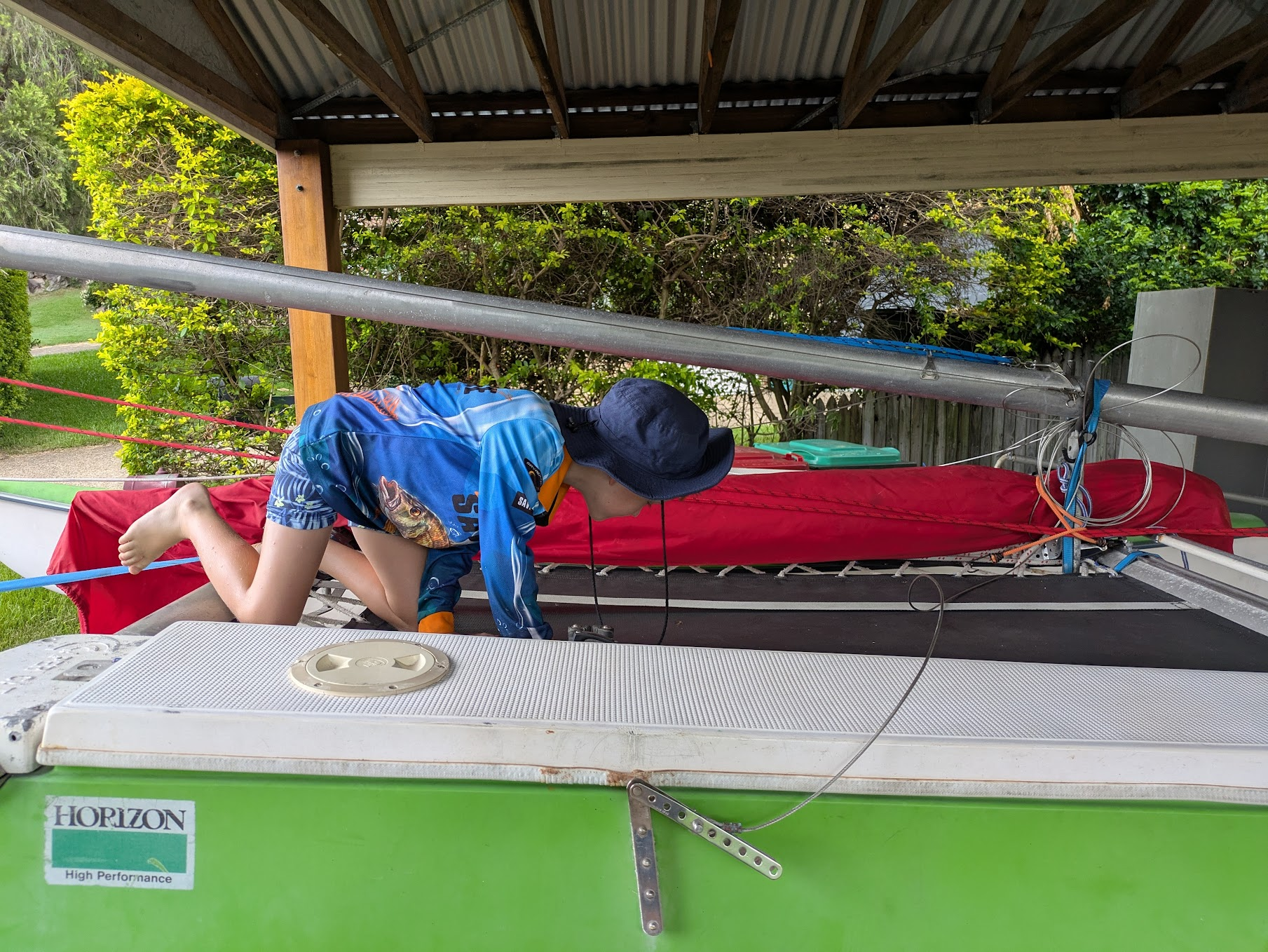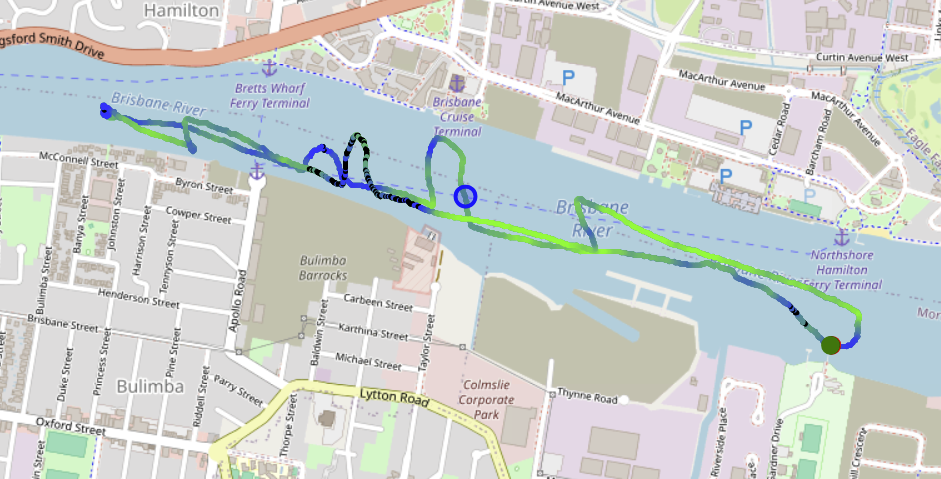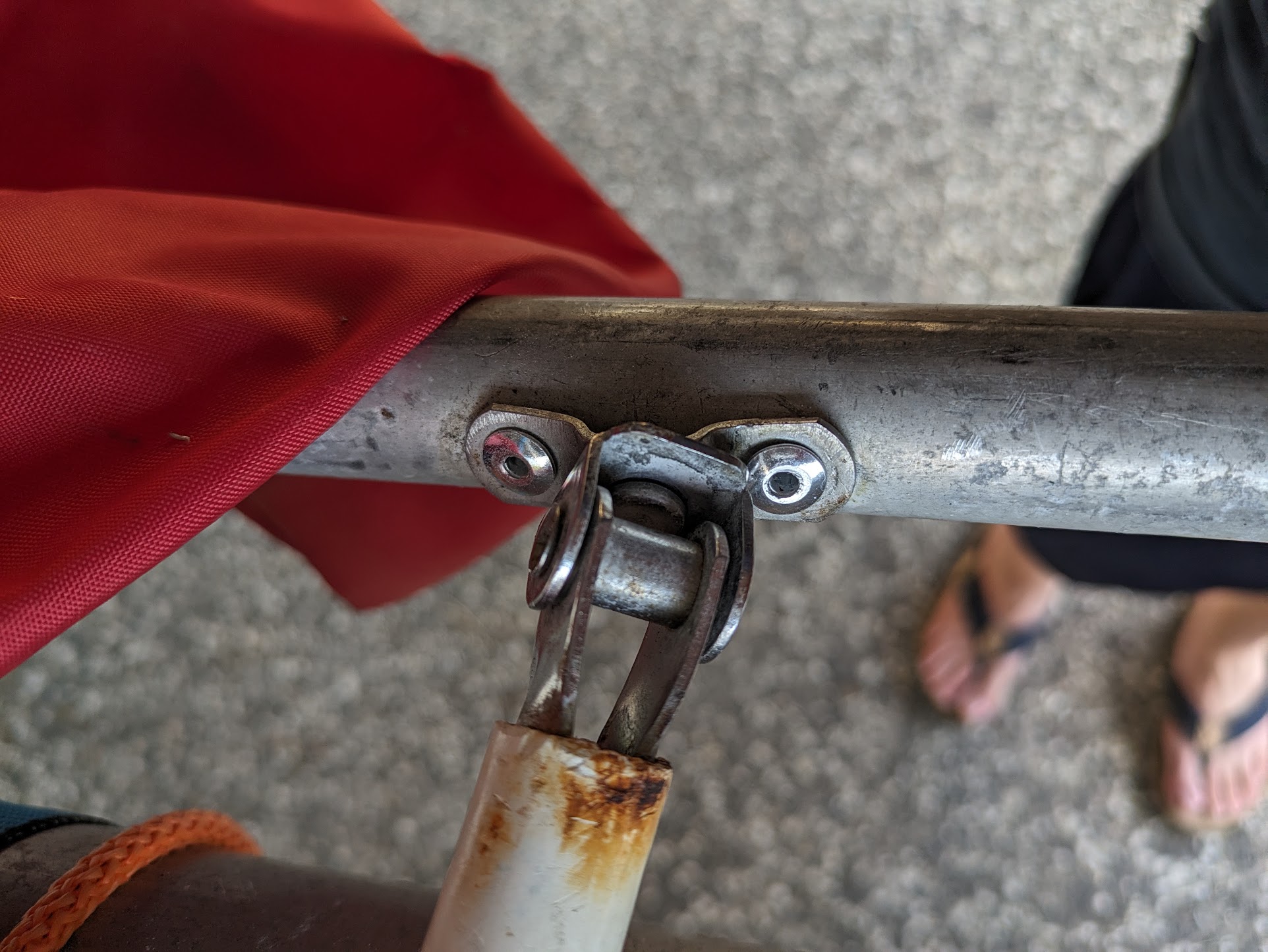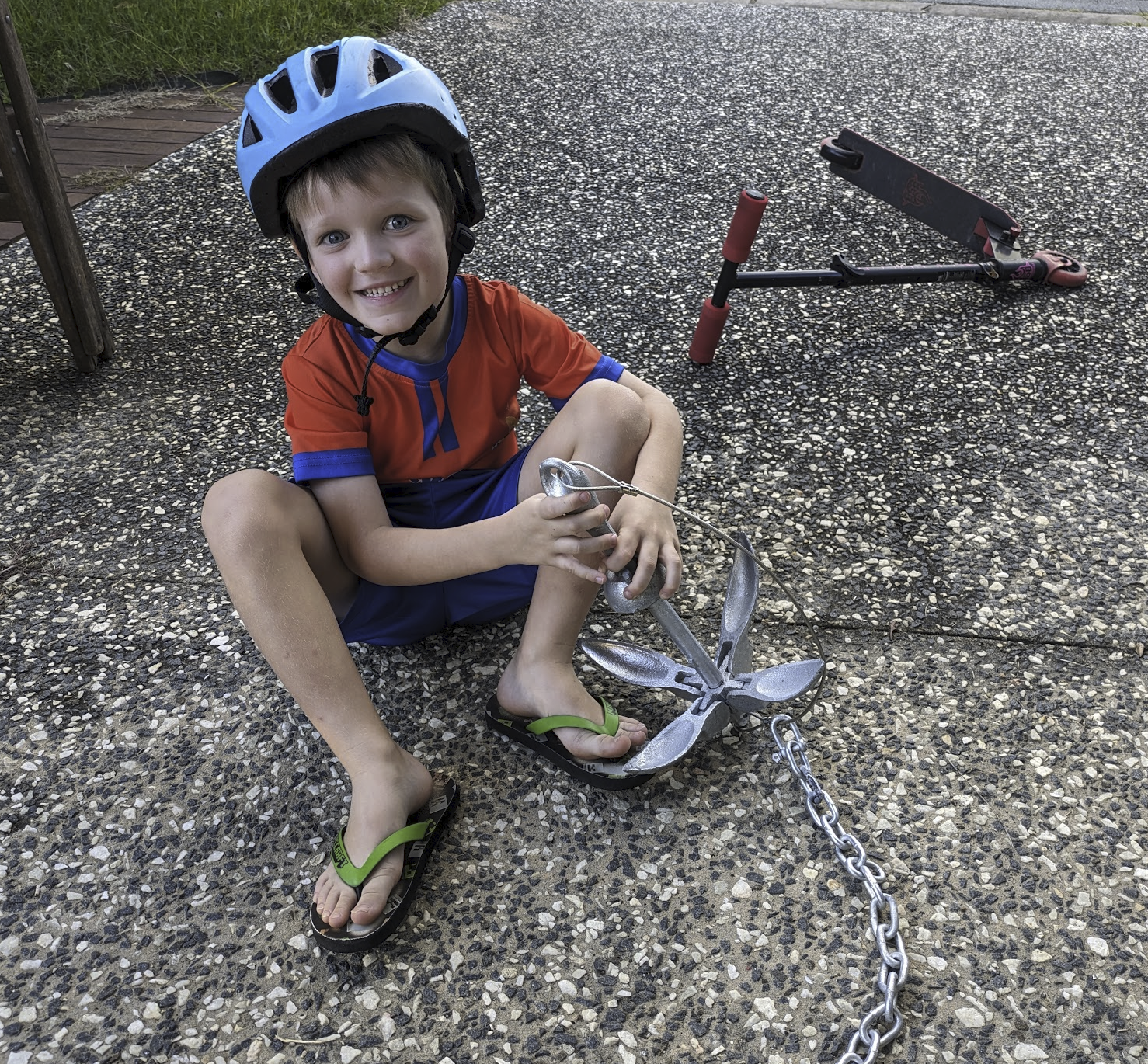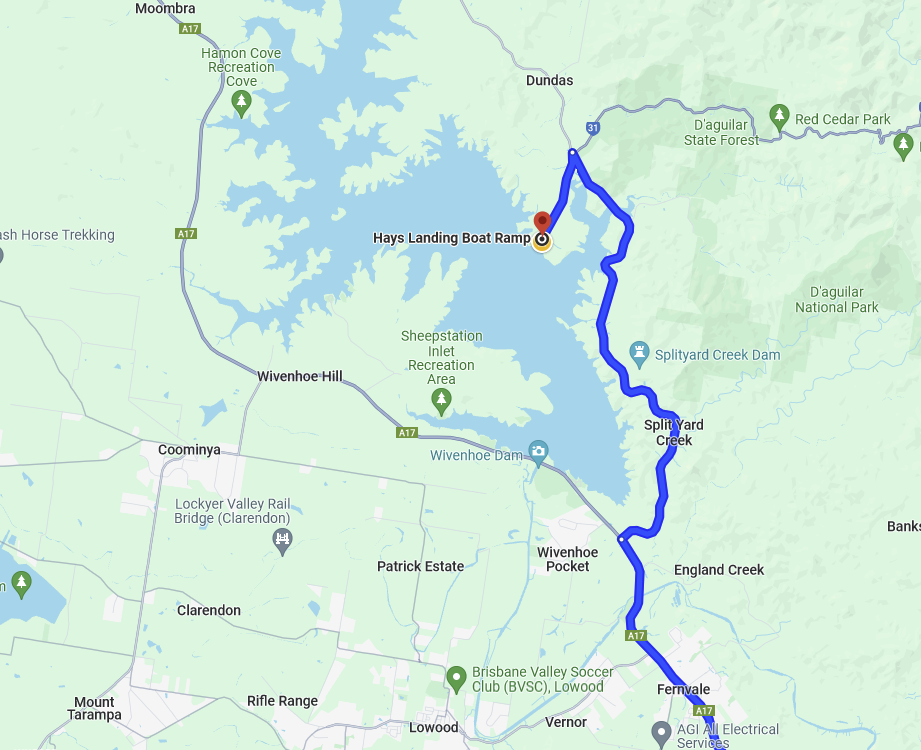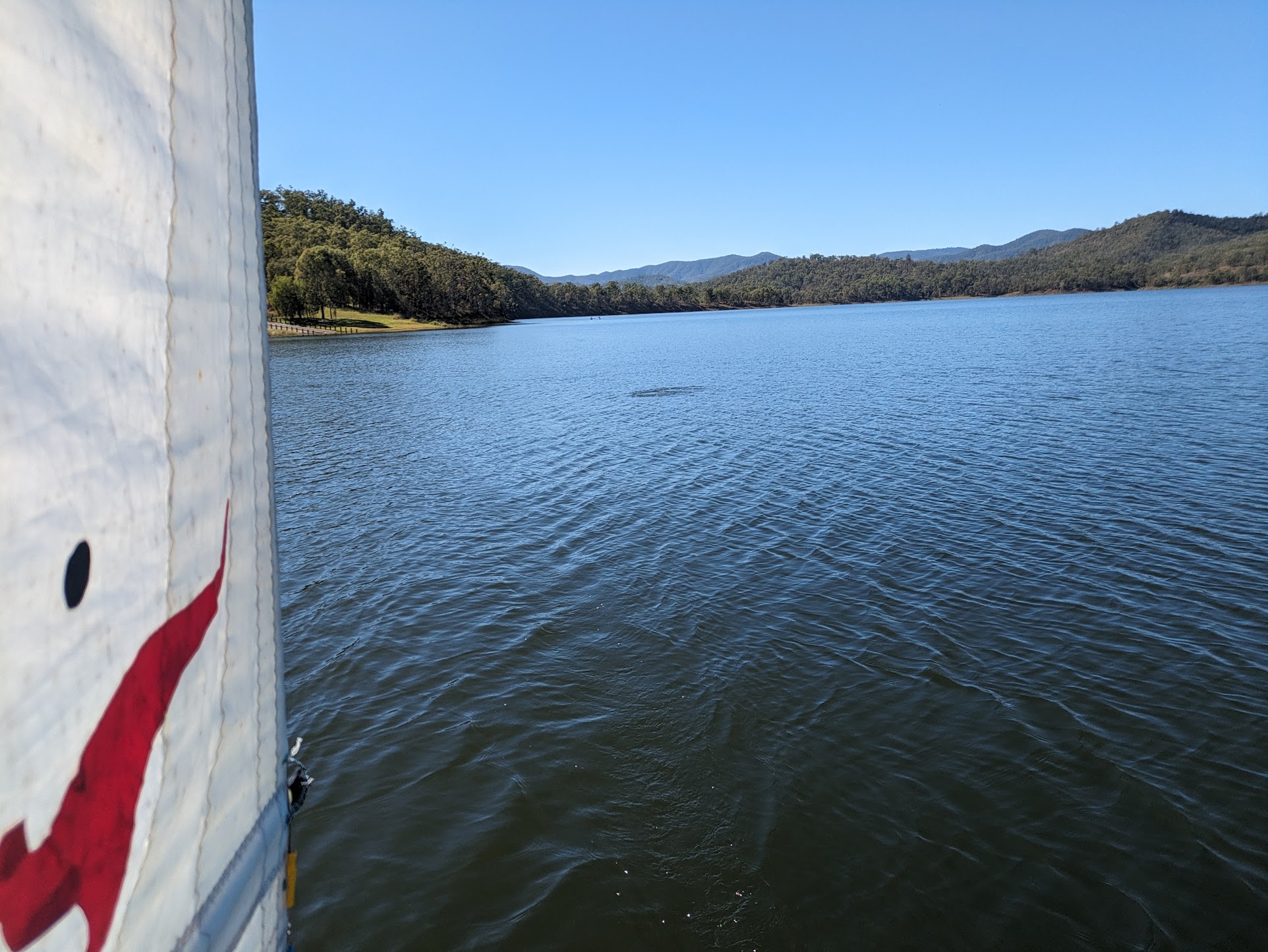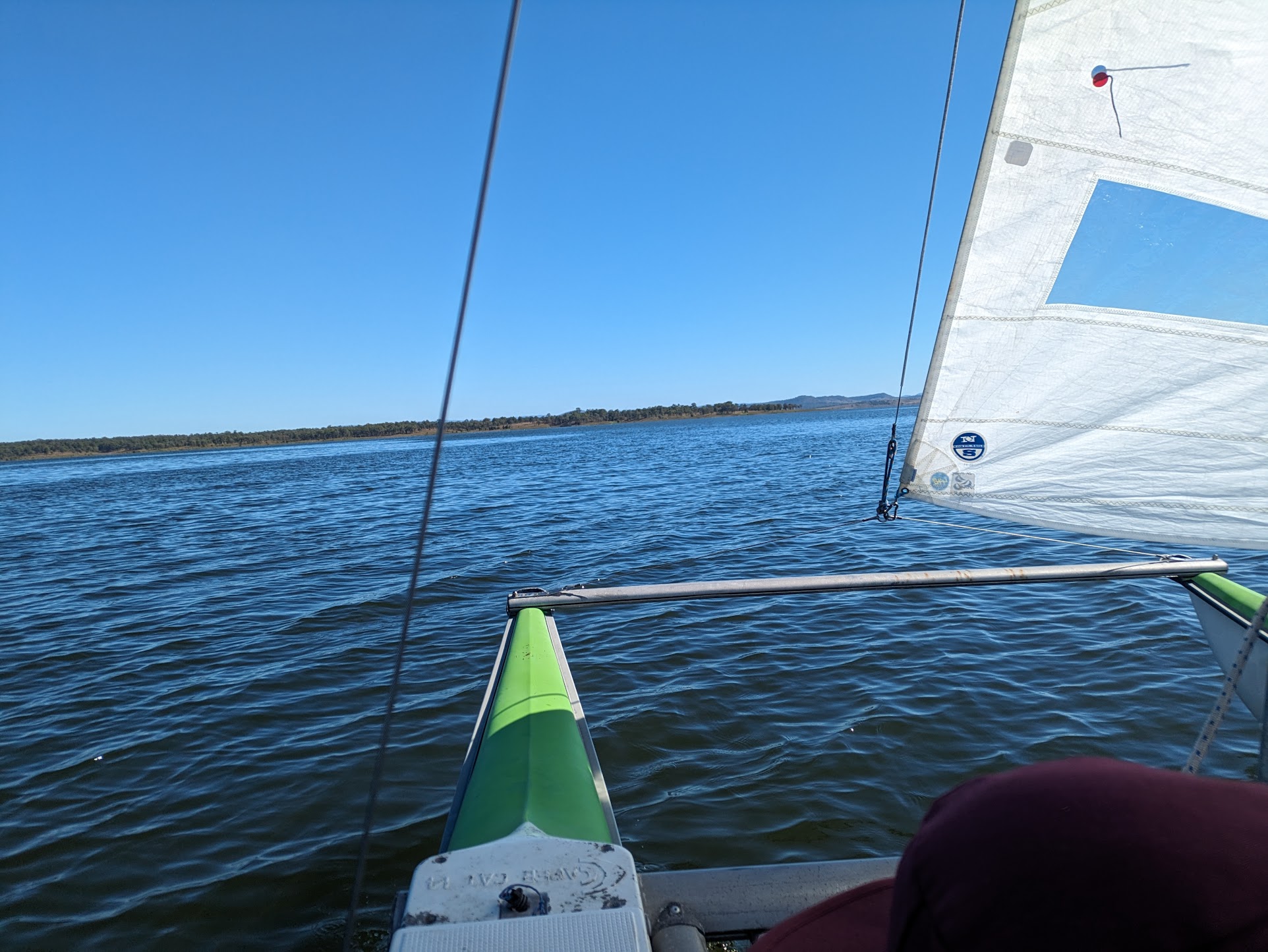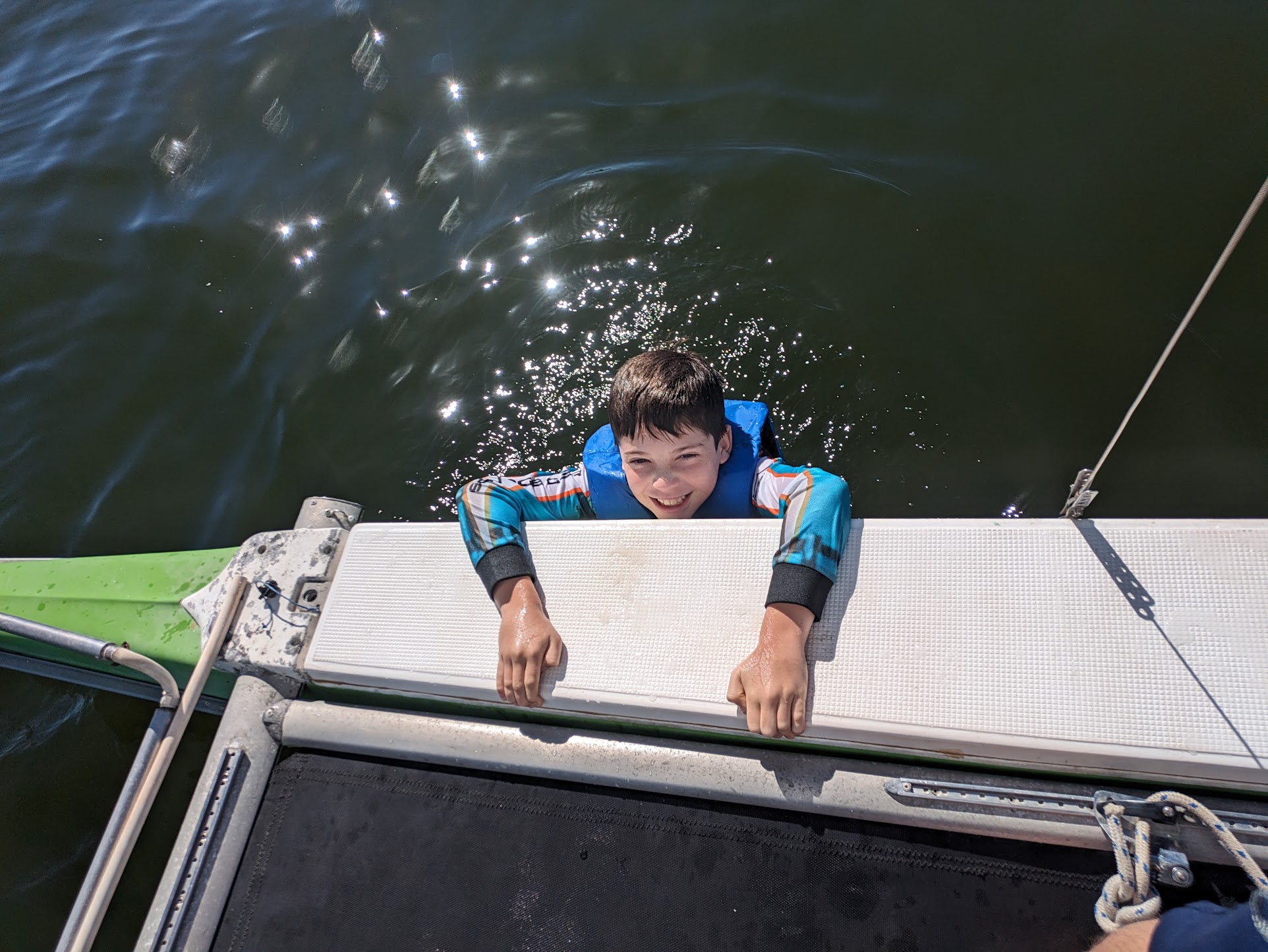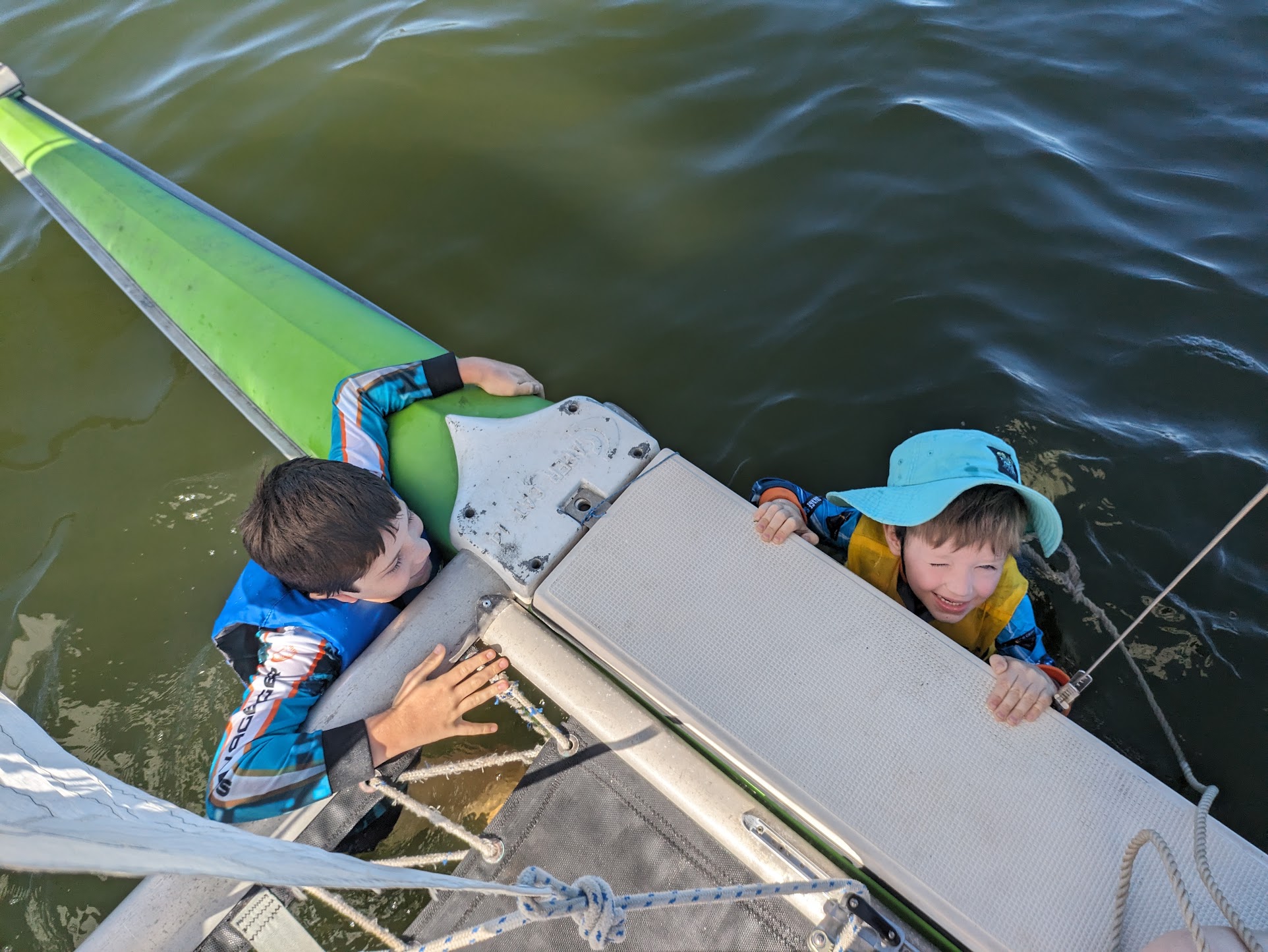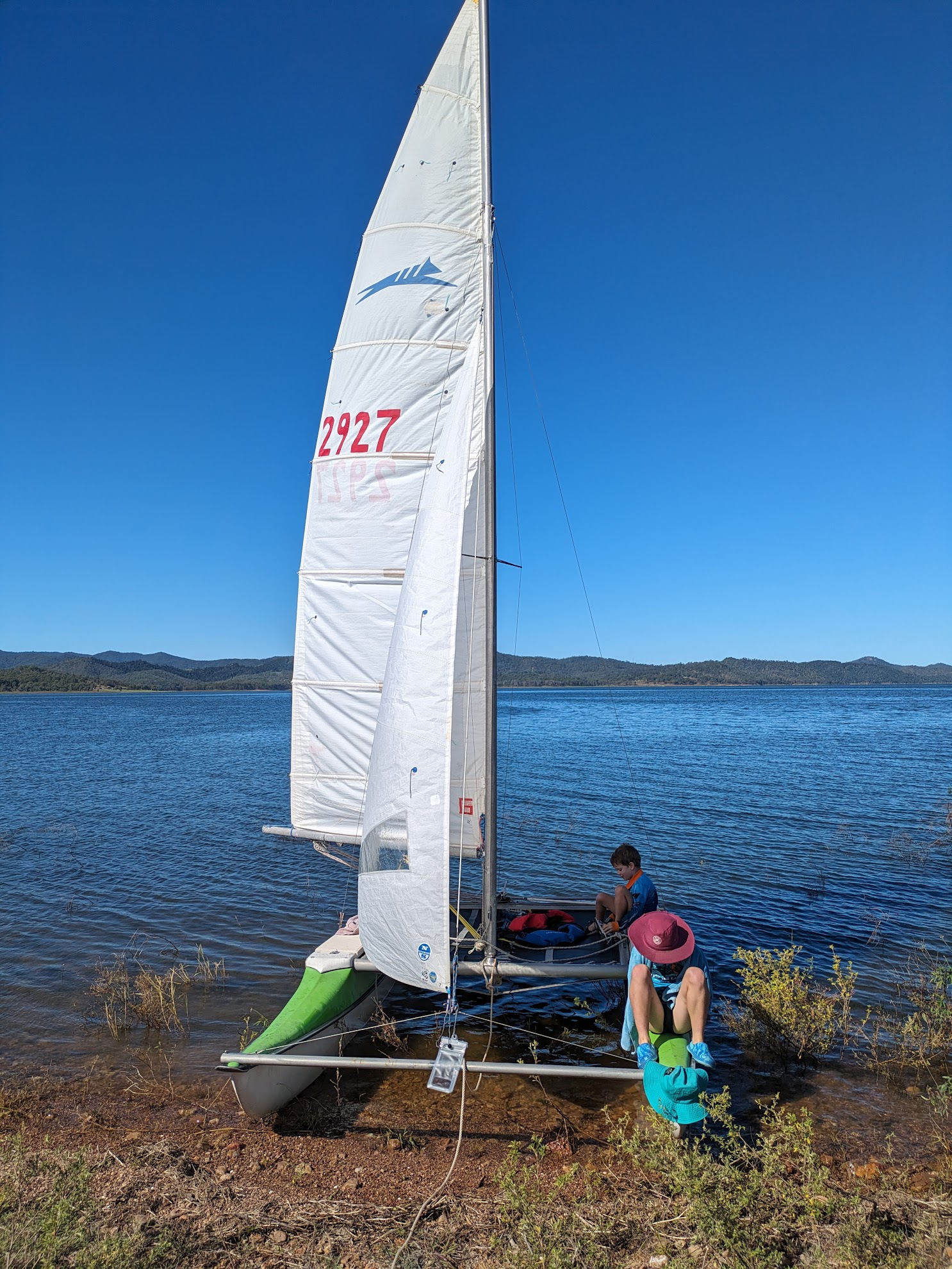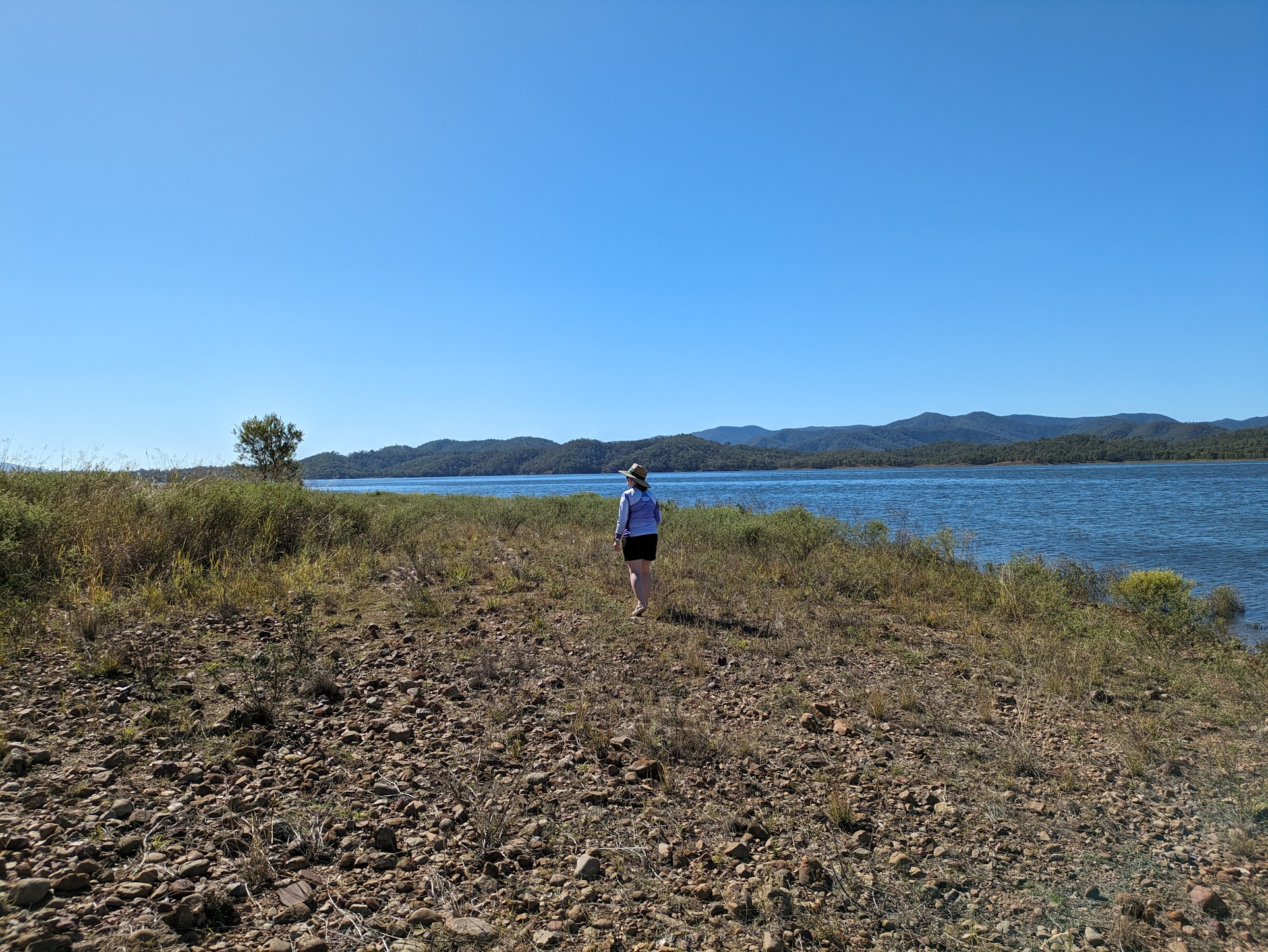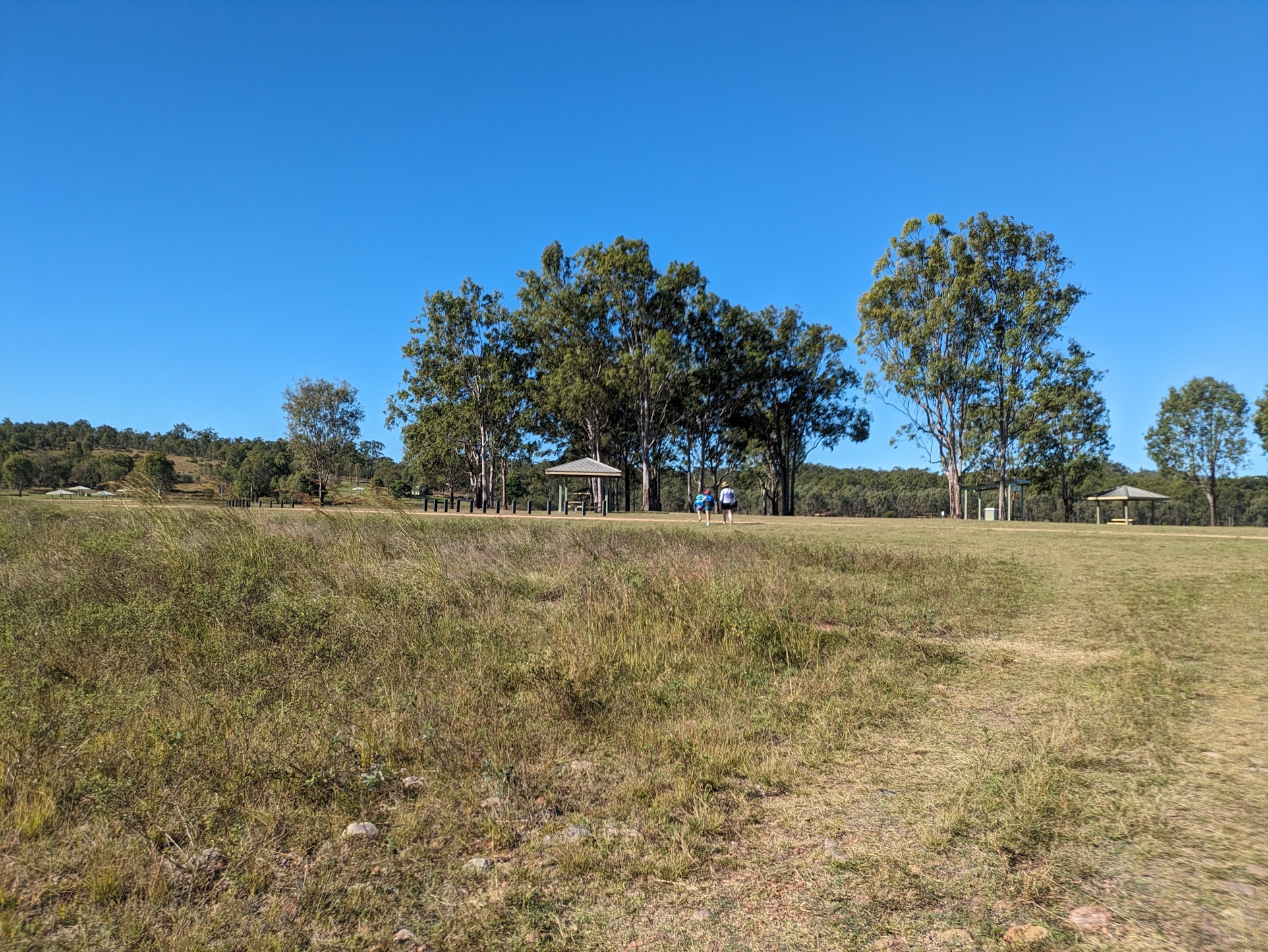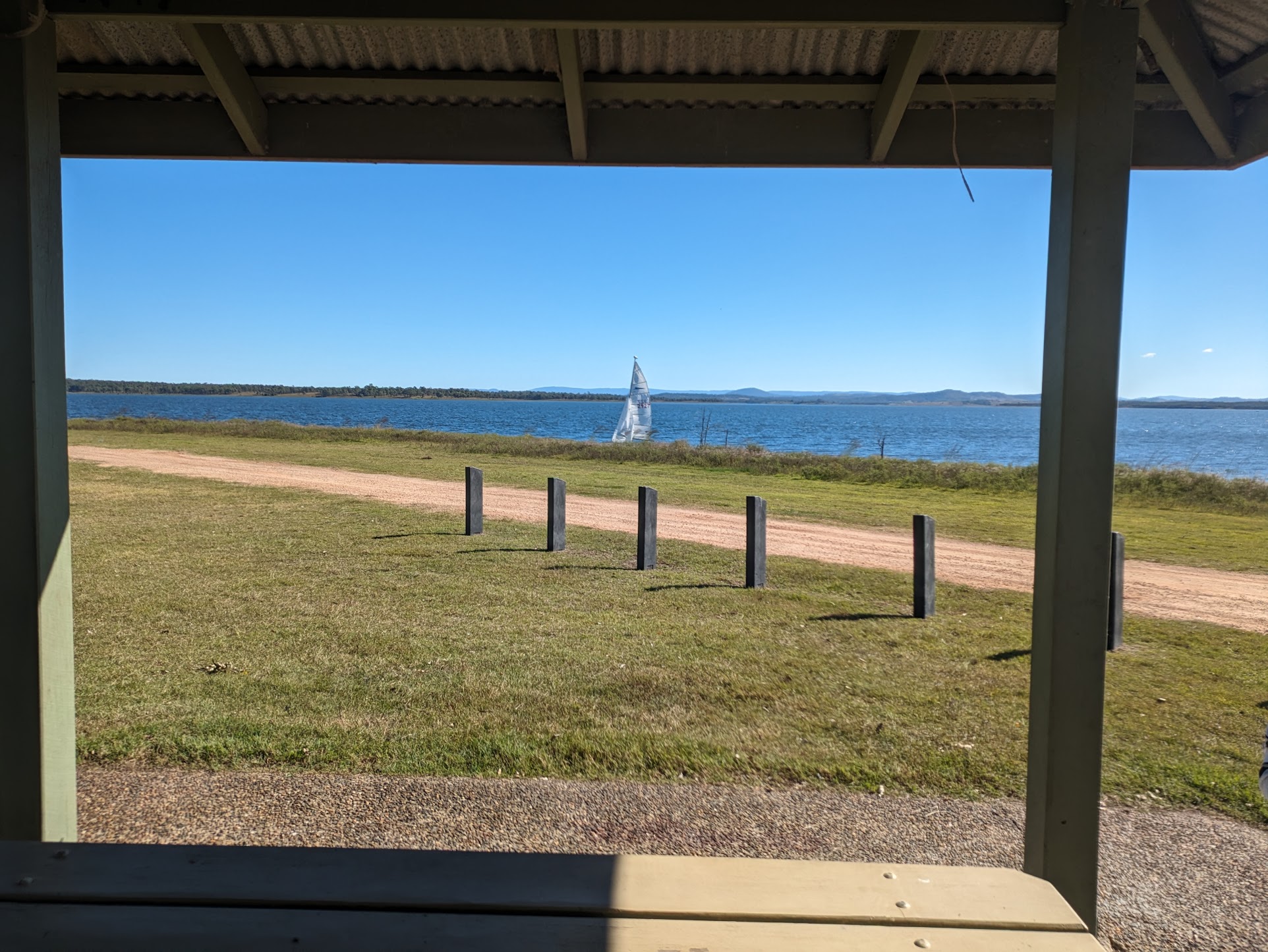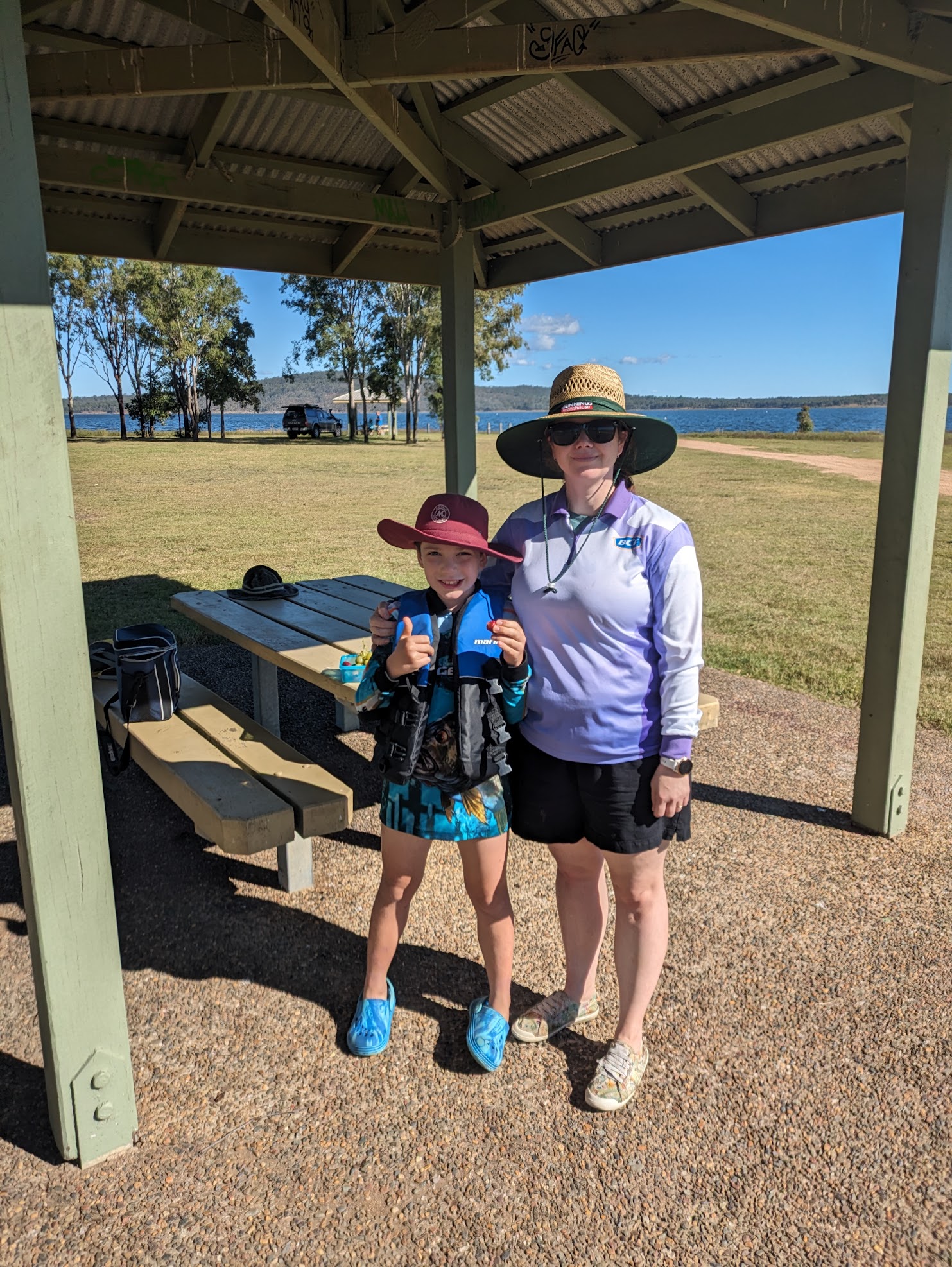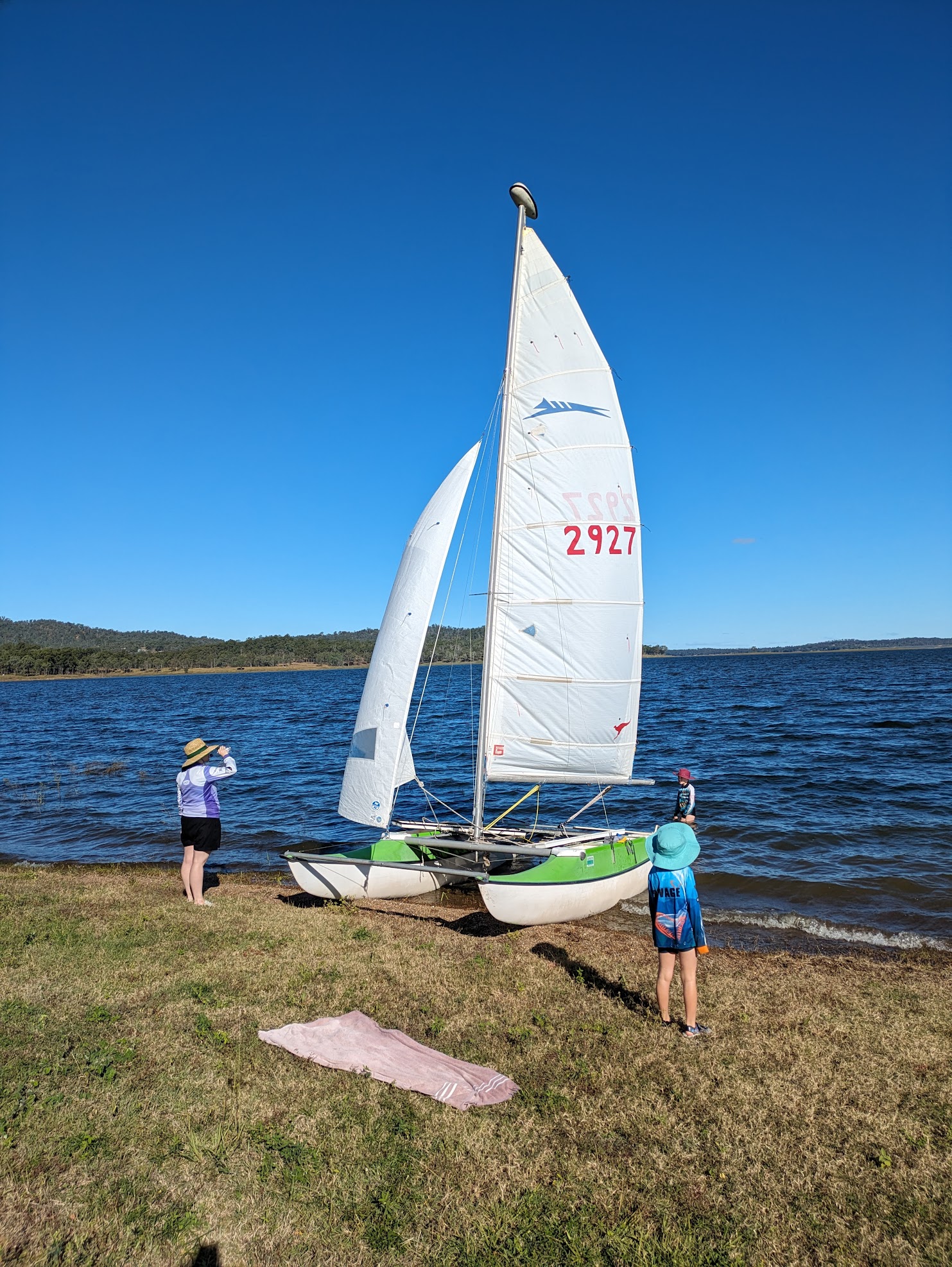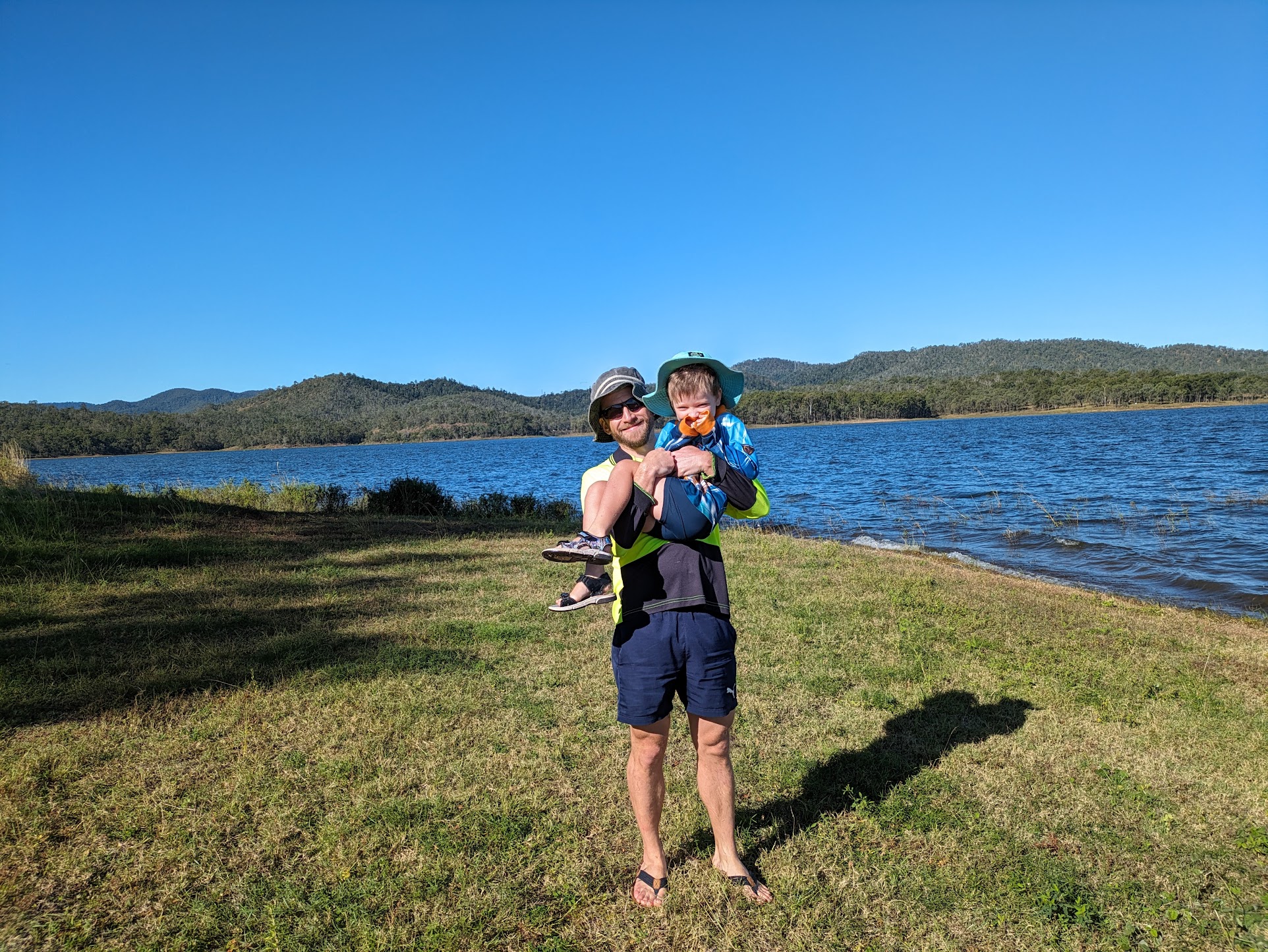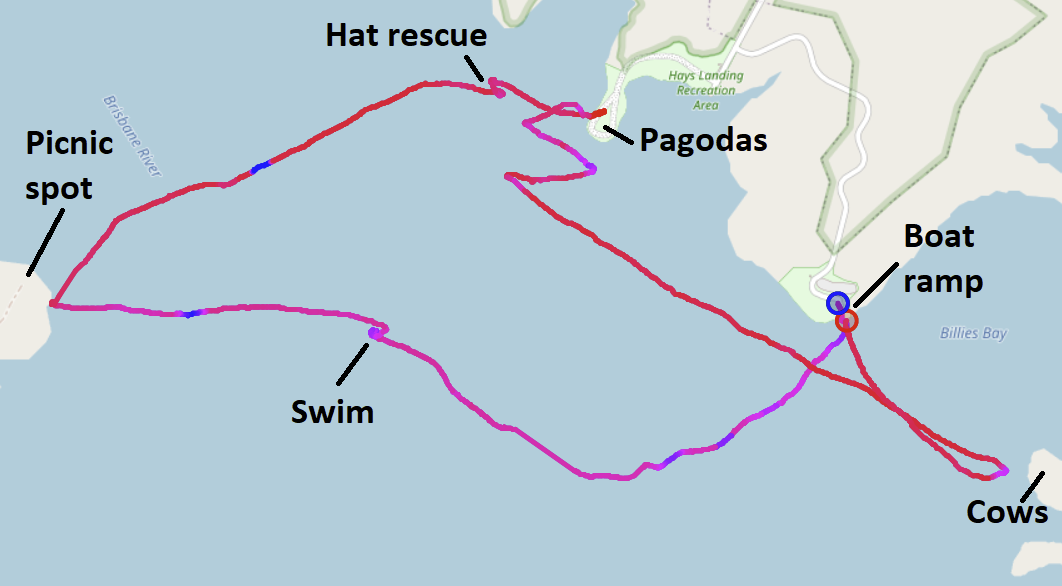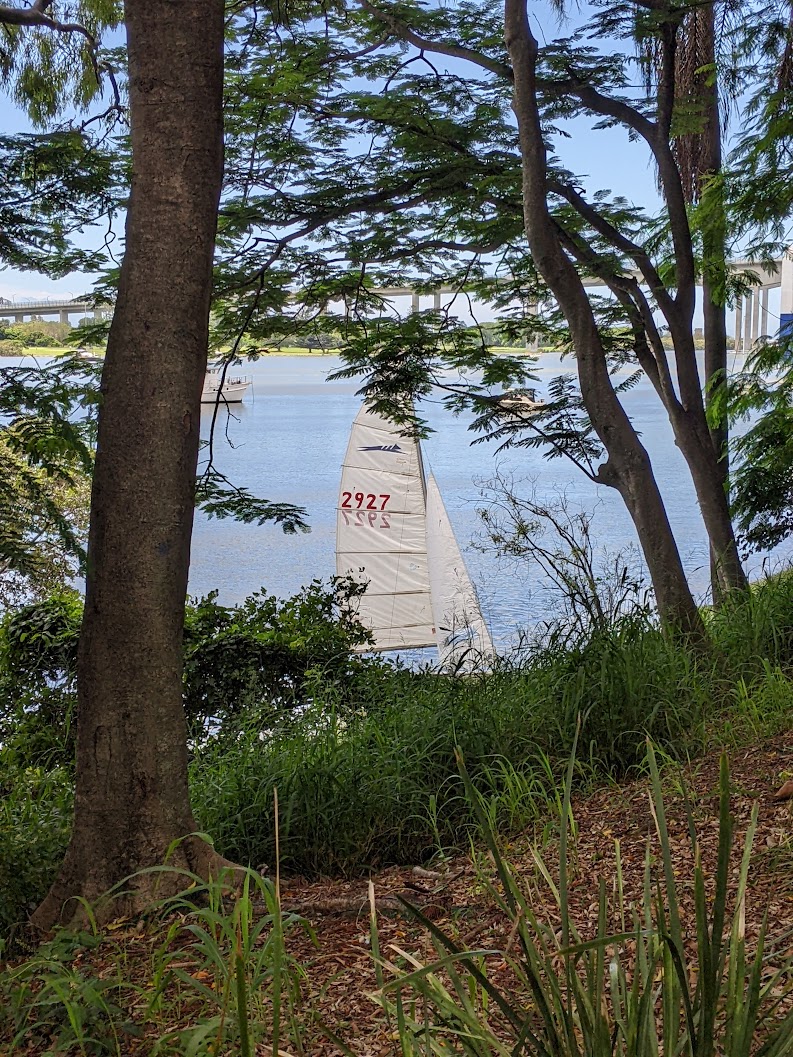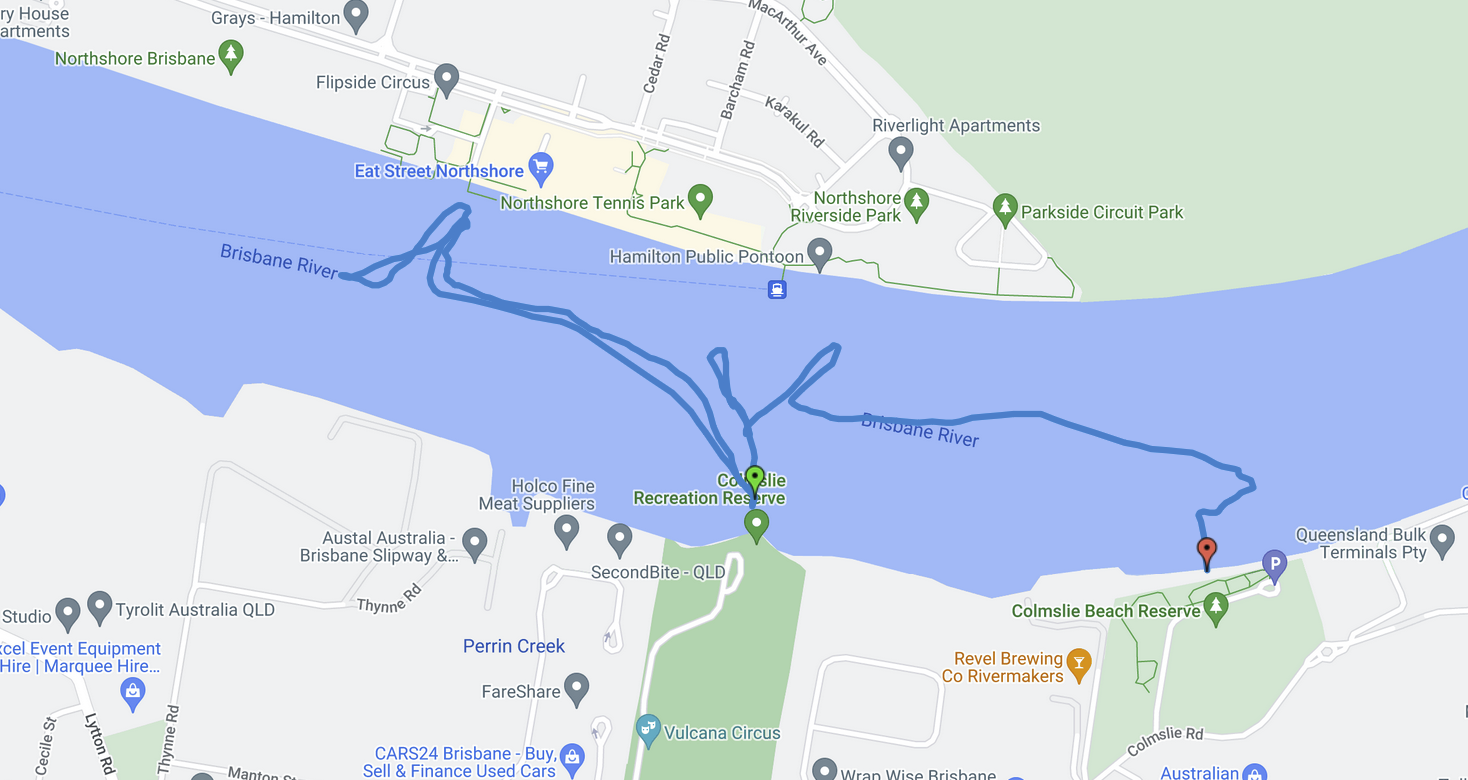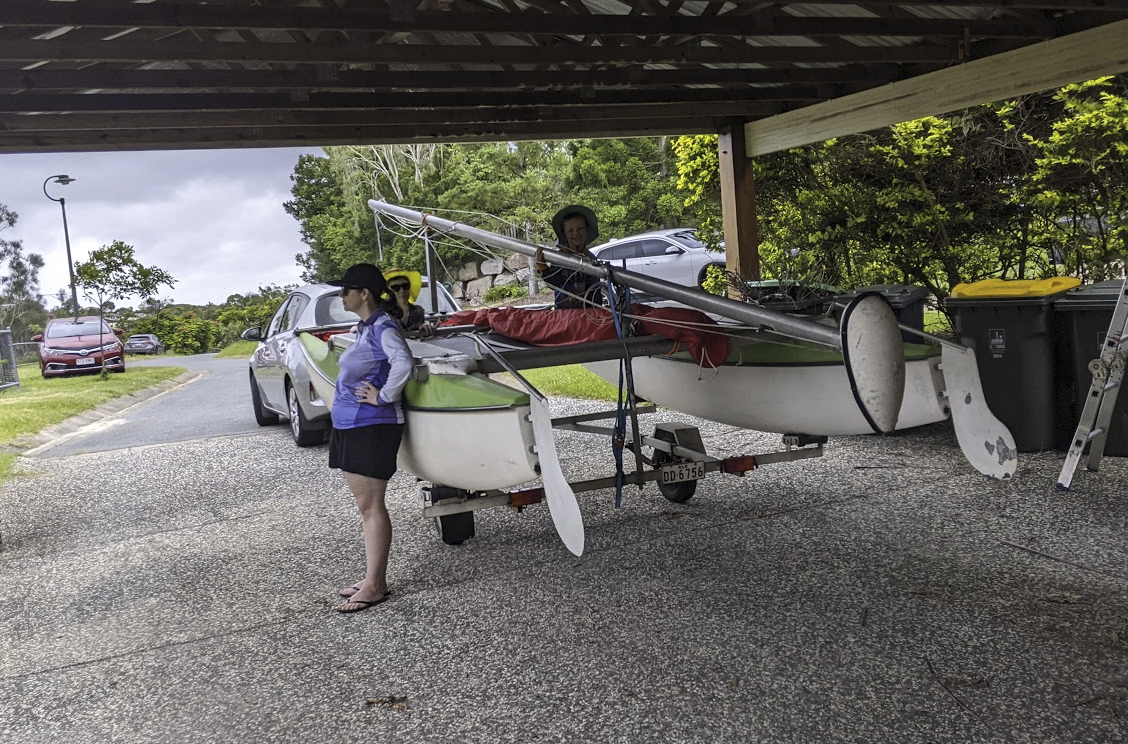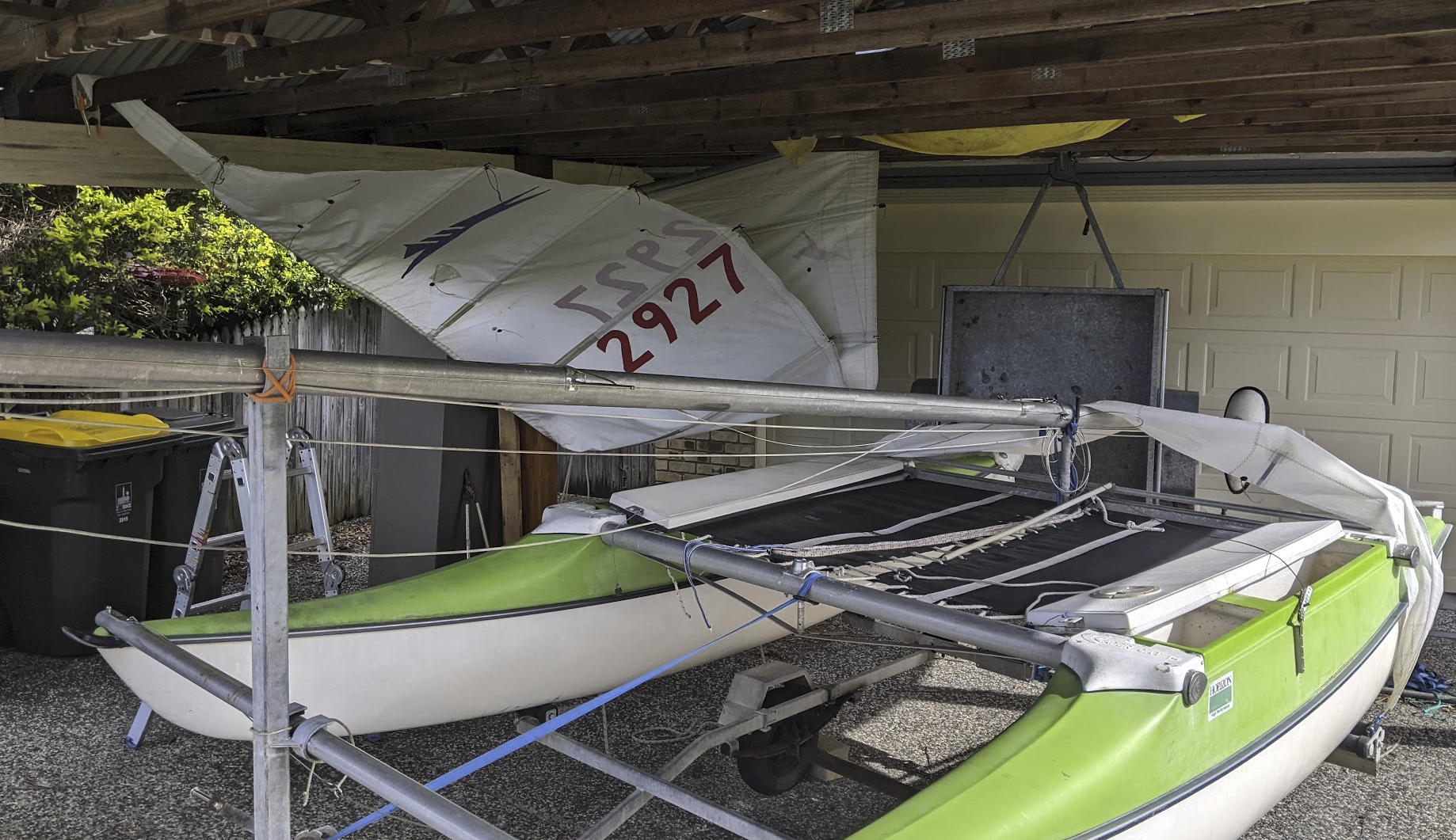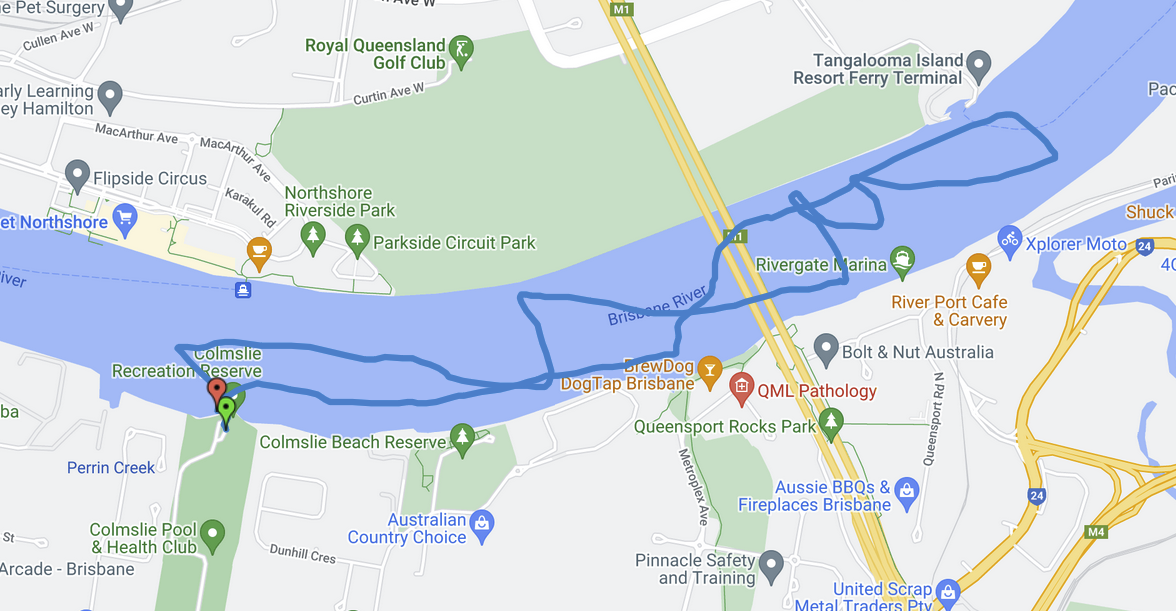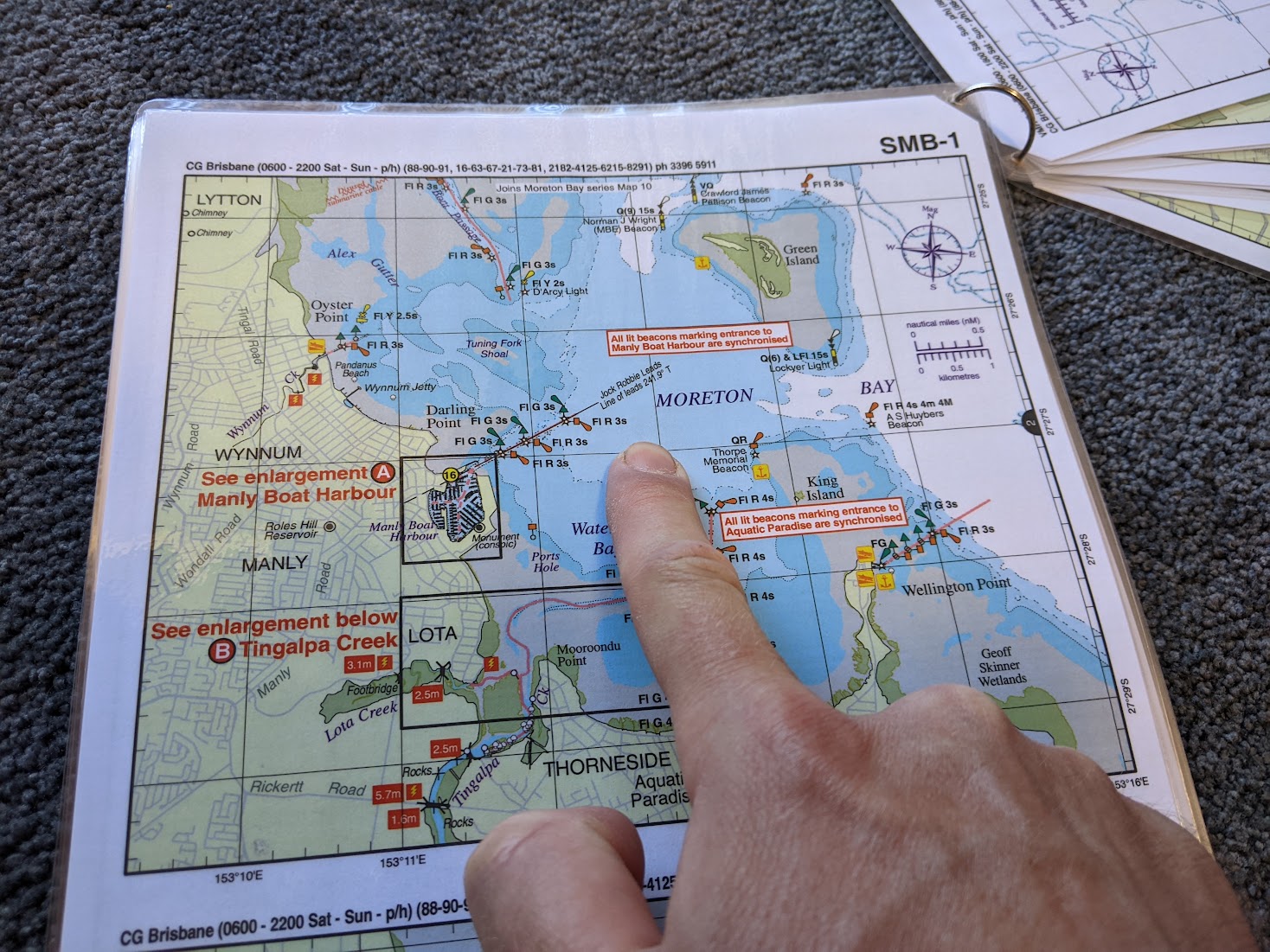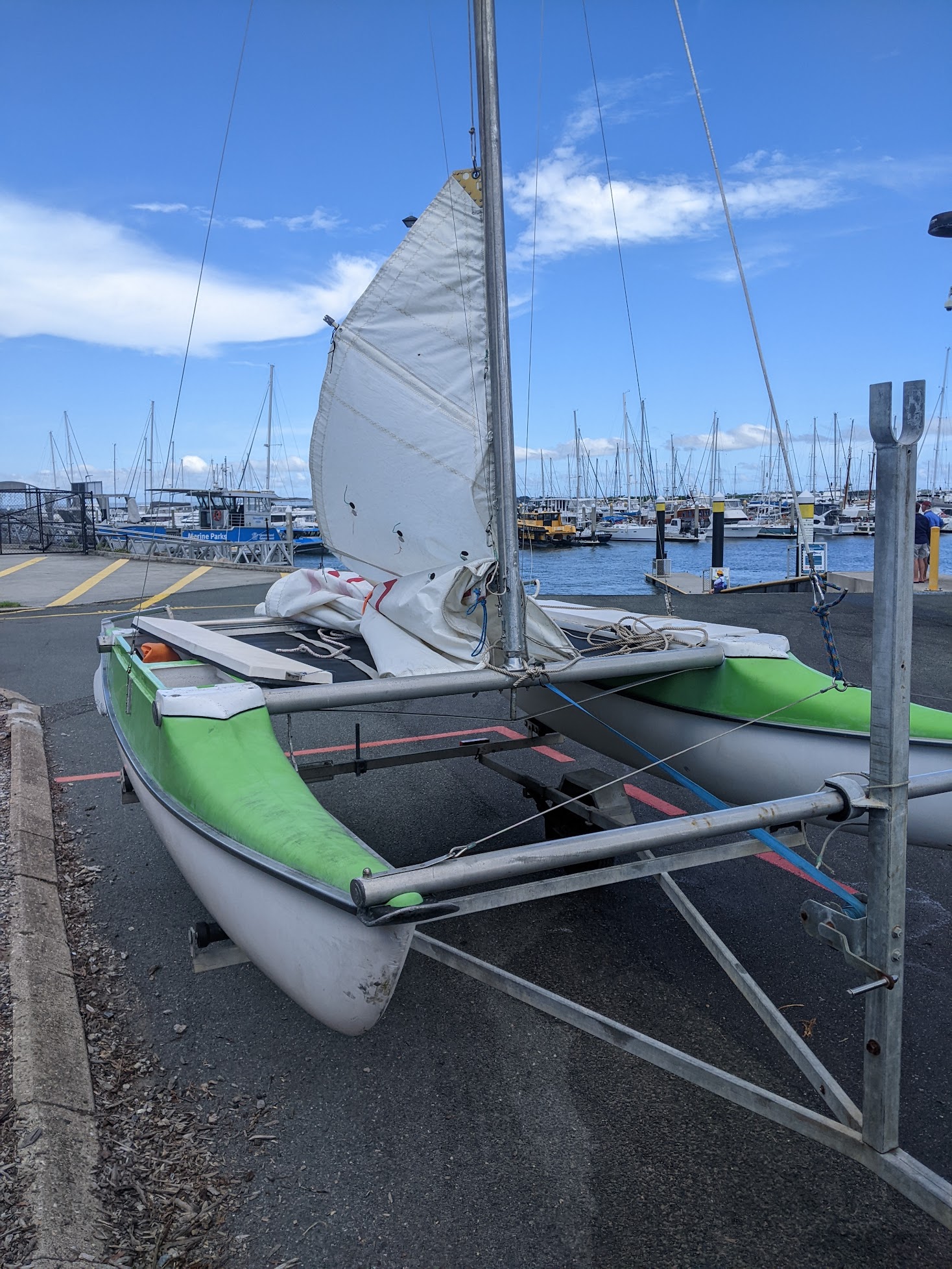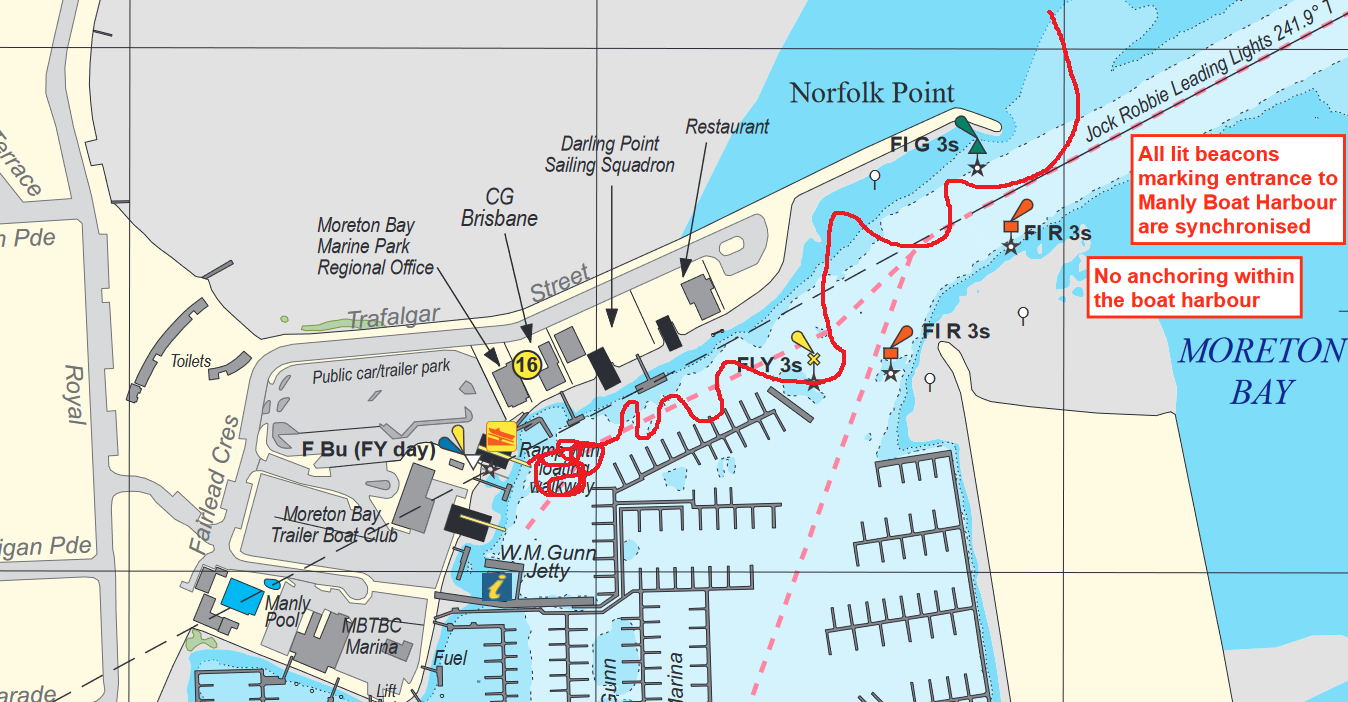Table of Contents
Summer 2024-2025
In a gap between two surgeries we rushed out for a quick afternoon sail.
2025-02-01
This was our first outing with the new halyards and the gopro. The forecast was for 10-13 knots. It was gusting to about 18-20 when we got there, with a light drizzle. We got out into the water without too much hassle. Michelle narrowly avoided throwing the car keys into the river. I succeeded in throwing my sunglasses into the river, but managed to retrieve them before they sank.
Michelle recorded a brief snippet of footage while we were underway. I need to build a mount to attach it to the end of the boom.
The boltrope on the foot of the mainsail pulled out of the boom again. The outhaul had come loose again. The new halyards worked great. No worries at all. Unfortunately I forgot to record the track of our journey. Next time, for sure.
Spring 2024
Winter's over! Sailing season is here again! We had a brief attack of 35°C weather, then it dropped by 10°C, then it warmed up a bit again.
2024-09-01 Father's day
On Australian father's day I invited my Dad out on the river with the boys and me. This time I decided to take us upriver to check out Newstead. We'd be sailing past HMAS Moreton and a few citycat stops.
For this outing I wanted to try a different way of rigging the jib. Our jib is slightly undersized for the boat, so there's a fair length of halyard, about 300mm, between the head of the sail and the pulley on the mast. This means the head can flop about when we're getting close to tacking, spilling wind. This can make it difficult to maintain momentum through a tack. As an experiment I threaded the forestay through the halyard shackle, and secured the jib tack slightly higher up along the forestay, rather than right at the bottom where it usually sits.
We launched from our usual Colmslie recreation reserve boat ramp and headed upriver. There was a nice 10 knot northerly and patchy cloud cover. There were a few citycats cruising around. Sailing downwind of the big apartment blocks on the north shore was a bit annoying as the wind was pretty squirrelly. We tied off to a floating anchor point marked “NOT FOR PUBLIC USE” just off some fancy riverfront houses in Bulimba and broke out the eski for some apple slices, mint slices and zooper doopers. The wind spun us around the buoy a few times as we ate.
After the break we sailed back downriver to the boat ramp. We had some difficulty in tacking once or twice. My new jib rigging didn't seem to have helped much. Both the halyards are quite stretchy. I think it might be worth replacing them.
Winter (??) Sailing
It's starting to get a bit cooler here in Brisbane. By which I mean it gets below 20°C at night. Spare us your scorn, we know we deserve it.
2024-05-06 The river
Another trip out onto the Brisbane river from the Colmslie recreation reserve. Not much to report on this one. We had a bit of trouble launching due to dock congestion, but we got out and had a good time. I lectured the kids on the loathsome game of golf and its barren monocultured hellscapes. We had a play around with the boom vang on our downwind run back. Kept the boom much more well-behaved. Lost my sunnies into the river when I was dropping the sails. RIP.
2024-05-19 Wivenhoe Dam
The stars finally aligned! We had a free Sunday coming up and a 8-10 knot forecast. We had a few things to check first. I picked up a new handful of cheap sunnies from the safety shop, and I tightened the loops holding the luff of the jib stretched along its leading edge wire. Hopefully this should keep it happier.
I replaced the rivets holding the tiller onto the arm joining both the rudders, they were getting a bit loosey-goosey.
I showed Sam how to deploy our tiny little anchor. If it looks woefully inadequate: that might be reasonable.
I got the boat all packed up and ready to go on the night before, using a new checklist I put together:
☐ Radio ☐ Bungs ☐ Charts ☐ Water ☐ Food ☐ Sunscreen ☐ Life jackets ☐ Anchor ☐ Sails ☐ Reef shoes ☐ Leatherman ☐ Sail tape ☐ Tape ☐ String ☐ Multigrips ☐ Spare rope ☐ Trailer tires pumped ☐ Gopro ☐ Key floats ☐ Tell someone where we’re going and when we’re getting back
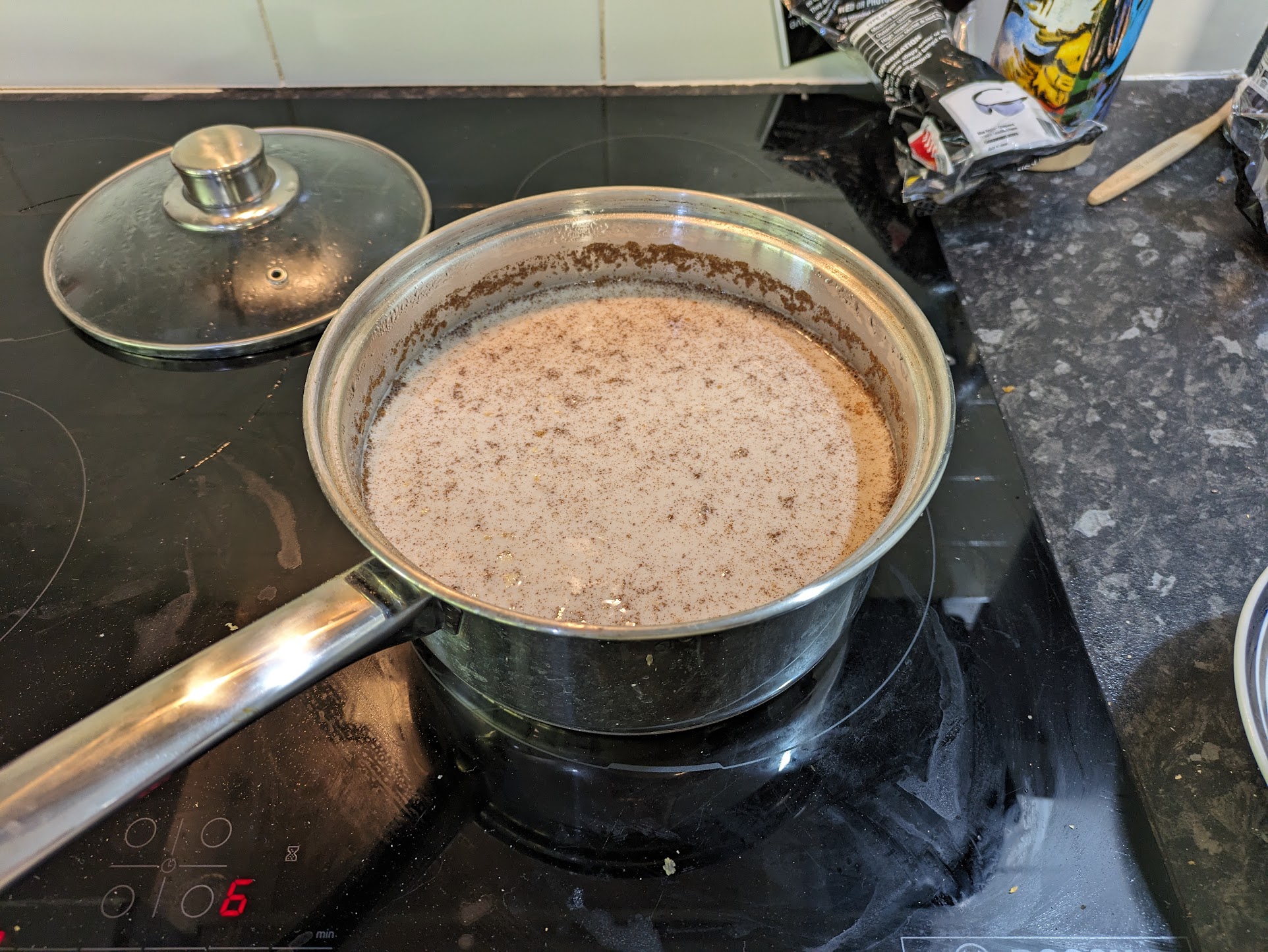 Getting up at 08:00 on a Sunday, early by our standards, demands a pot of porridge to bribe everyone out of bed. I may have overdone the cinnamon.
Getting up at 08:00 on a Sunday, early by our standards, demands a pot of porridge to bribe everyone out of bed. I may have overdone the cinnamon.
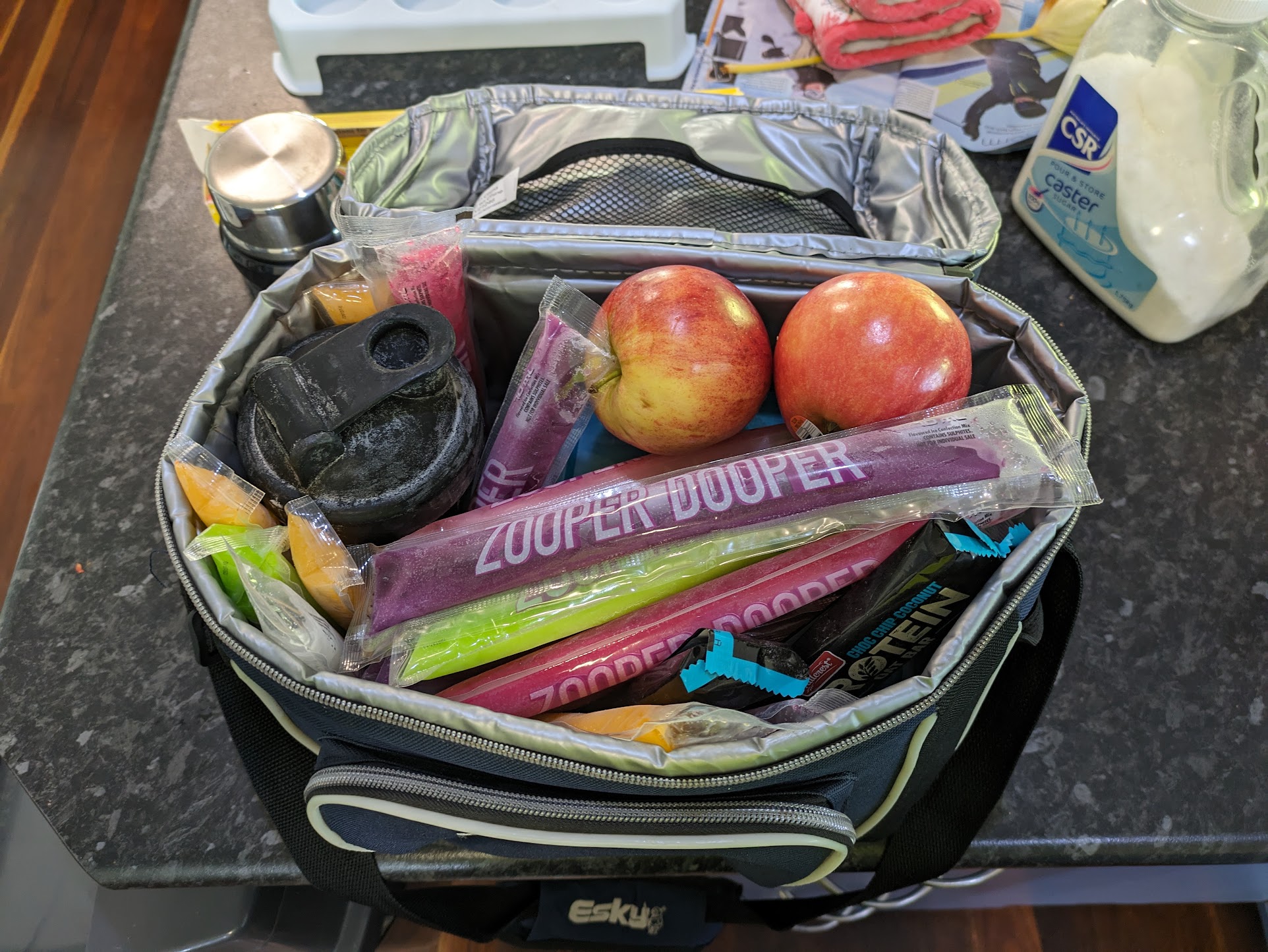 The traditional sailing lunch bag.
The traditional sailing lunch bag.
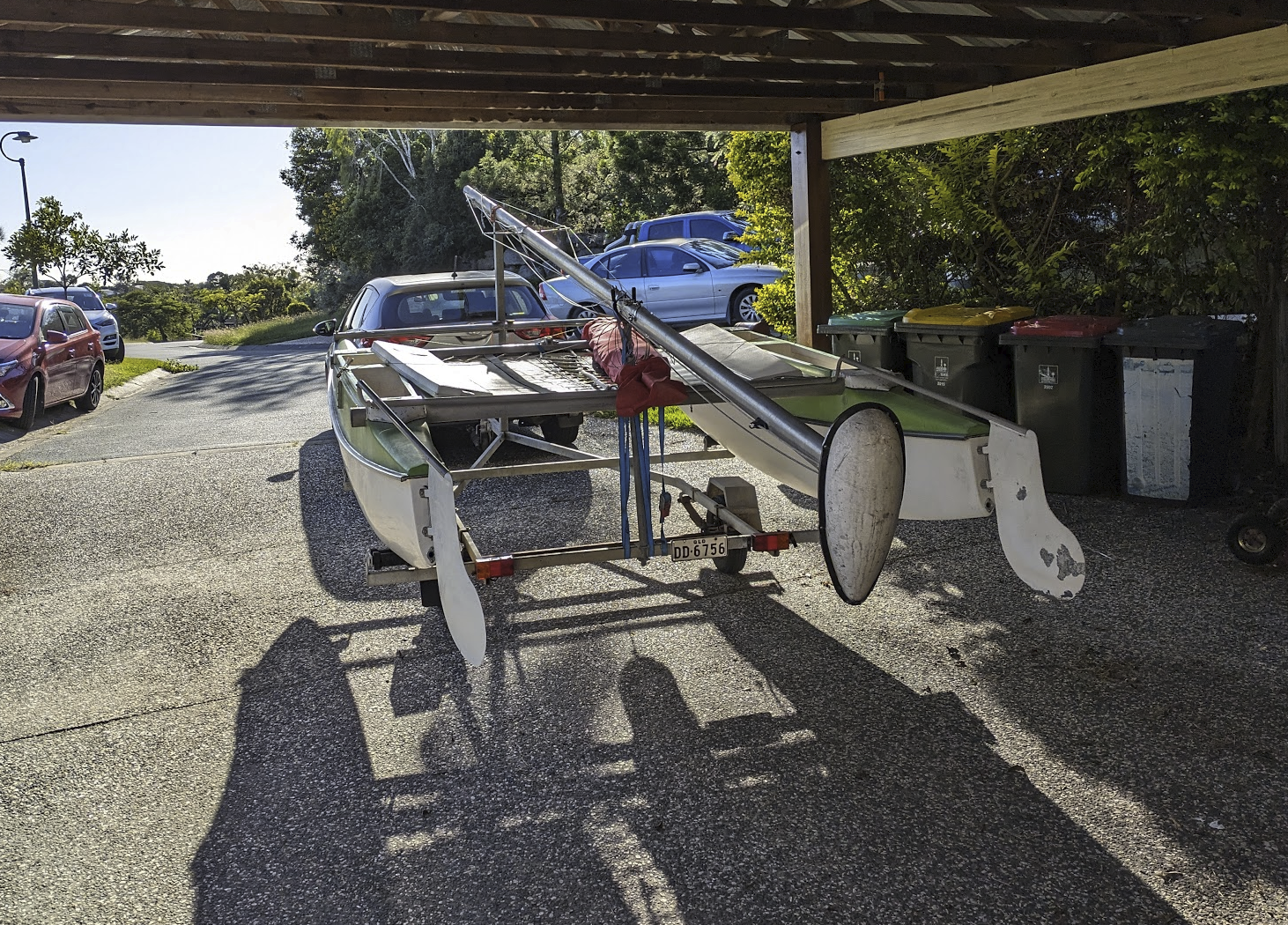 Mostly packed and ready to roll.
Mostly packed and ready to roll.
Wivenhoe is about 1.5 hours' drive from our place. I threw an extra ratchet strap around the top of the boat to hold it down to the trailer. This marginally reduced boat-flying-off-trailer anxiety. We decided to put in at the Hays Landing boat ramp.
The drive was uneventful. We listened to a few episodes of Sawbones to keep the kids sane. We got a few spectacular peeks of the lake and the dam itself on the way in. The Hays Landing boat ramp was closed when we got there, so we diverted slightly to the nearby Billie's Bay ramp. By the time we got there the extra strap I put around the boat had worked its way loose and was flopping uselessly. Erk.
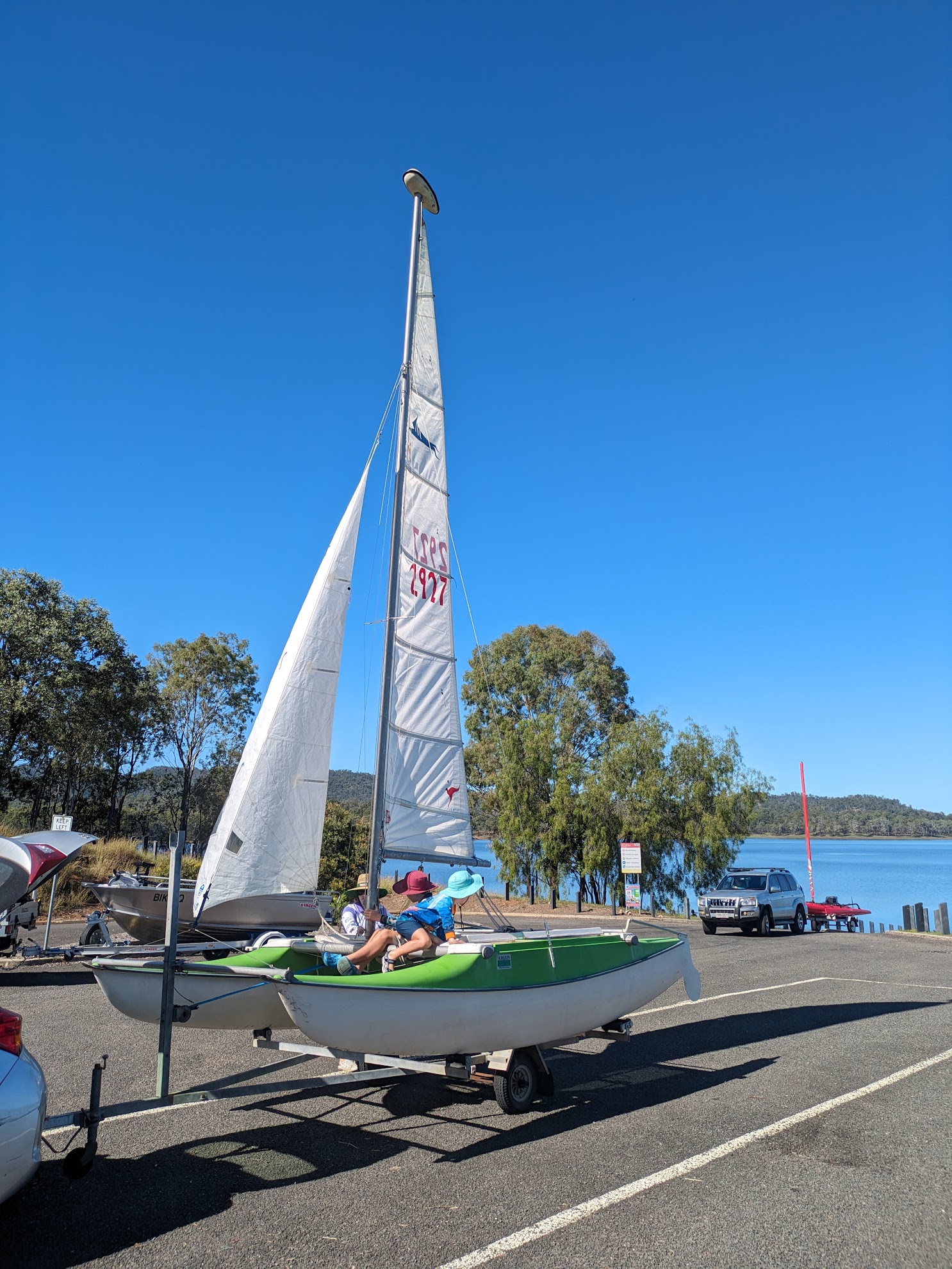 Alex and Sam doing pre-launch checks.
Alex and Sam doing pre-launch checks.
The sky was a perfect blue gradient while we rigged up, without the slightest breath of wind. C'mon BoM, don't fail me now. I was given hope by another sailor turning up at about the same time as us. He had an eastern European accent. Czech? Bulgarian? Ukrainian? We had a chat with him about his boat. He had a kind of turbo-kayak, with a sail, retractable outriggers, oars, and a sweet pedal-driven flippy-flappy underwater paddle mechanism. Very cool.
Just as we launched the wind started to pick up enough for us to get underway. Phew.
Our loose goal was to explore around the dam and find interesting stuff. There was plenty of wildlife about, including pelicans and herons/egrets. The kids had been nagging us for ages to let them go for a swim off the boat. We didn't really want to do that in the Brisbane river, as it is pretty scummy. We took advantage of a lull in the wind by throwing in our brand new anchor, followed by the kids.
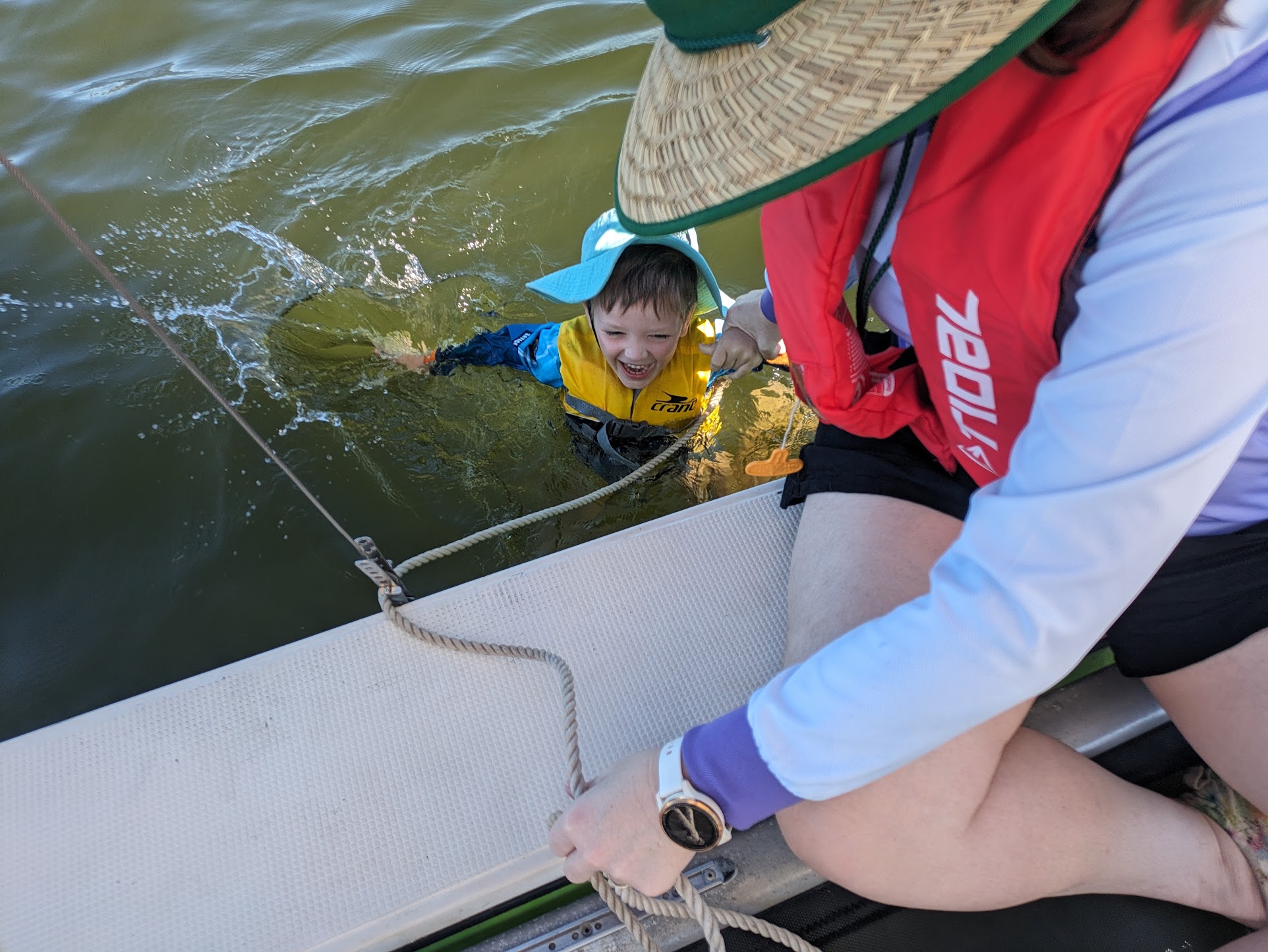 We tied a rope around Sam's life jacket, just in case.
We tied a rope around Sam's life jacket, just in case.
Both kids pretty quickly soured on swimming around the boat, possibly due to the extremely reasonable Deep Sea Willies combined with the cold (for us) temperatures. Just after we got them back onboard the wind picked up and we immediately started dragging anchor as if it wasn't there. Lesson learned: Get a bigger anchor, or drop sails at anchor.
We pulled up on a clear patch of shore on the far side, about 2.5km straight across from where we started, to have a walk around and stretch our legs. We found a lot of cool rocks. There was a Turdis barely visible on the other side of some scrub. We later learned that slightly further along the shore was a dedicated boating stopping point, with a picnic table, toilets, and a bin. Whoops!
After our stop the wind picked up to around 10-15 knots. We zoomed back across the dam to check out a picnic area just north-west of the boat ramp. Michelle lost her hat, as per tradition, but we recovered it without incident.
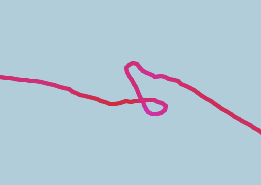 The crossing point shows where the hat landed.
The crossing point shows where the hat landed.
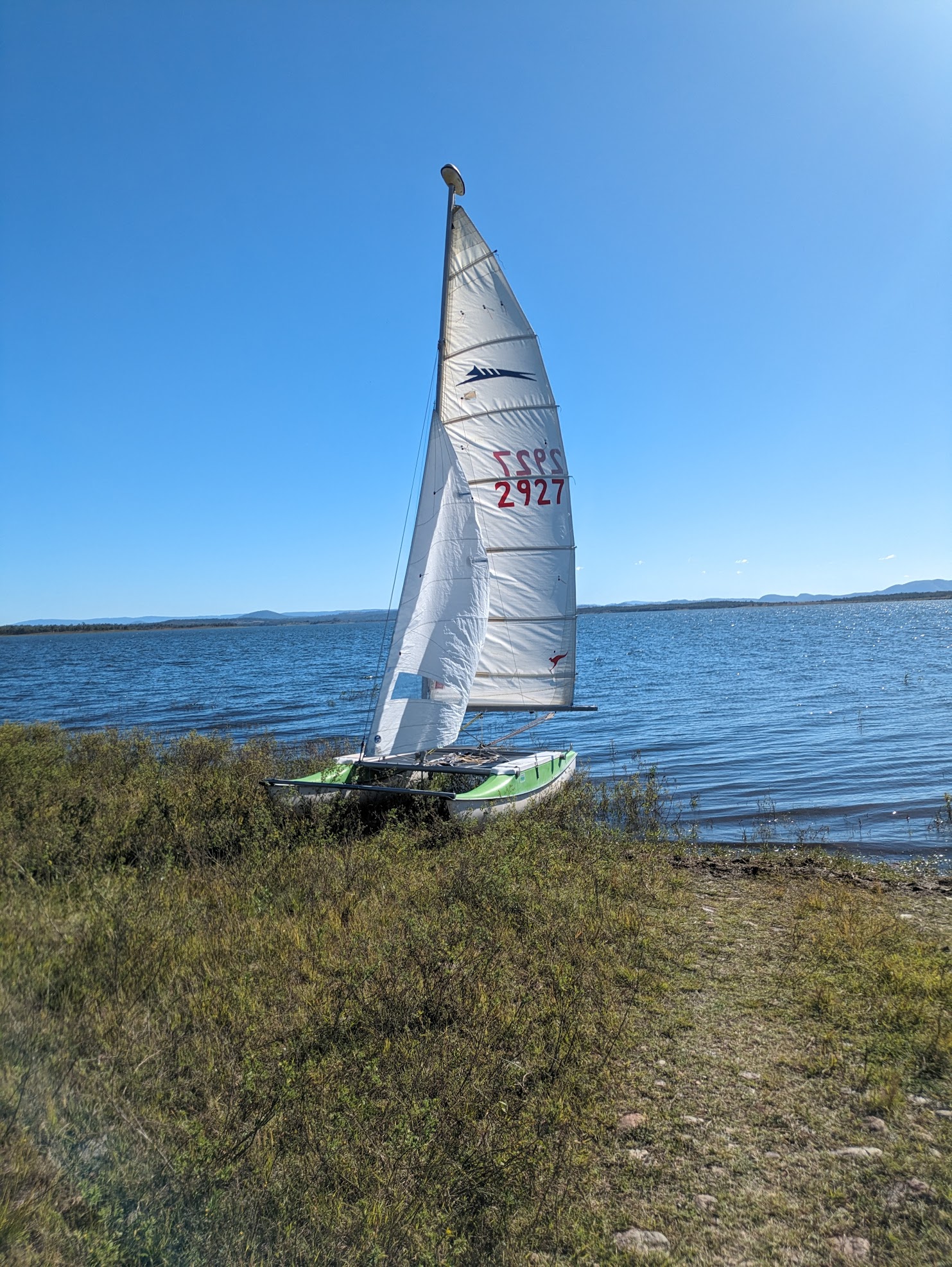 Our second stop, at the Hays landing BBQ spot.
Our second stop, at the Hays landing BBQ spot.
I was a little concerned the building wind would carry our boat off the shore, so we had a quick afternoon tea and got back underway quickly. Some people on the shore came to watch us sail off. We were getting some good splashes over the bow and the kids didn't appreciate getting soaked. We decided to head back to the boat ramp, but not before a little extra exploration to see some cows.
And that's about it! The kids were zonked and fell asleep in the car on the way home. Next time we come out here we're going to be more ambitious and head up to an island we can see on the maps, and maybe visit the stopping point around the corner from where we first stopped.
Video
Brisbane River
We went for another couple of sails on the Brisbane river from the Colmslie recreation reserve.
2024-01-14 Mum and Dad
We've managed to avoid any serious sailing mishaps, growing our confidence in our boat and our abilities. I invited my parents to come out with us on a day with some gentle wind. At the ramp I talked my Dad through helping me raise the mast. With him, Alex and Sam onboard we headed upriver a short way and checked out Eat Street from the perspective of the river. We crossed paths with a CityCat, who gave us a friendly toot, then headed back to the dock to swap in my Mum. We had very light, intermittent winds; perfect for leisurely sightseeing. We pootled downriver to the Colmslie Beach reserve for lunch. The tide was 2.8m, of an absolute 2.9m max, so the beach was entirely underwater.
I picked a spot relatively free of swimming kids and cruised up onto shore. I did run straight over someone's fishing line but they didn't seem to mind. I think they were preoccupied with the novelty of a sailboat crashing into the shore. I bush-bashed through some long grass towards a tree to tie off the boat. Something in the brush spiked through my reef shoes into my foot. I'm not sure what it was, but I got a tetanus shot the next day just in case.
Meanwhile Dad had driven from the boat ramp to the beach, going via maccas to pick up some lunch. We managed to beat him there on account of some drive-through misunderstandings. We'd just finished up lunch, including the customary zooper dooper dessert, when an ice cream van drove into the carpark blasting greensleeves. It took a few seconds for them to drown in a tidal wave of kids.
We hopped back on the boat, paddled out out of the shoreline wind shadow and made a straight run back to the dock to disembark. A great time was had by all, except for Sam who said it was “too boring”. I remembered to start a path recording on my phone, but forgot to turn it back on after lunch.
2024-01-27 Windy
We'd planned to head out to Wivenhoe Dam on this public holiday, but we had a bit of a sleepy start to the day and didn't get out the door until about 11:00. Wivenhoe's a little over an hour's drive away, so we opted for another day on the river. The wind forecast was about 10 knots, gusting to 15.
There was a good drizzle coming down at the boat ramp, something Michelle felt compelled to note regularly. There was lots of traffic at the boat ramp, many people were putting in jetskis and silently tutting at the softies doing the opposite to get out of the rain. The dock was covered with jetskis and dinghies so we put our boat in and guided it over to a little patch of beach nearby to get the jib rigged. I spent a good while trying to get the top of the jib taut, but our halyards (sail raising ropes) have too much spring in them to get things as tight as I'd like.
Rod, the resident boat ramp bogan, stopped by to compliment us on the tension of our forestay. Had had a mate with us who was very happy to see a caper cat. He reckoned it might date from the 80s. Rod also mentioned that we should have a “boom vang” on our boat for proper sail tension. A few hours after we got home that afternoon I realised why the boom and mast had fixing points spaced about half a meter from where the boom meets the mast (the gooseneck), and why we had an extra jumble of ropes and pulleys (blocks) laying around. I'd thought it was a spare main sheet but it's actually supposed to be used to pull the boom down to give the sail a better aerofoil shape. We'll give that a shot next time.
We headed downriver at a good pace. The wind regularly dipped entirely, but we got a few good zooms in on the way out under the Gateway motorway bridges. They're pretty spectacular constructions. We need to buy a rugged waterproof camera of some form so we can take photos while on the boat. I'm tempted to pick up a second hand gopro or similar. We had a look at a massive superyacht called “Helios”, possibly this one?. Recently sold for AUD$61 million. A cool AUD$380 000 to rent for a week, plus expenses (naturally). Jesus fucking christ.
We headed north across the river to check out a big green crane barge. It was big and green. The wind got pretty spicy around this point, with some solid gusts that launched us through the water. The recording of our path shows we peaked at 9 knots, or 16.6 km/h. There was about half a meter of chop, enough to break over the nose of the boat and soak us all. Sam was beside himself with joy.
We headed back upriver to the boat ramp. The dock was full as we approached, so we landed on the beach to take the sails down while the kids inexplicably filled their jocks with sand and rocks. Getting the boat from the beach to the ramp was a massive pain in the arse. I eventually worked out a system to keep the boat angled into the wind in a way that kept it from bashing into the side of the ramp while gradually working it down to where we could get it onto the trailer. Next time we'll wait for a spot on the dock.
I hung up and hosed down the sails when we got home. They were pretty grotty and covered in salt water spray.
Moreton Bay
We live in Brisbane, which is right next to Moreton Bay, on the eastern-most part of Australia. It's a part of the Pacific Ocean, or the Coral Sea if you're a tiresome pedant stickler for accuracy. The bay is protected by islands and is known to sailing dorks as a good place to sail. It's where Michelle and I did our keelboat lessons, out of the Manly Boat Harbour.
After a few leisurely river sails we thought we'd go out onto the bay for some more excitement. Our long-term goals are day trips over to islands in the bay. But first: paperwork.
Marine Assist
Volunteer Marine Rescue is an amazing institution. People who donate their time, effort and money to help make our waterways a safer place. If you get into a pickle they can send out a team to fish you out of the water and maybe tow your boat back to shore. They accept donations, but I figured it would be best to formalise the relationship by signing up for a marine assist service. This provides them a stream of income, $80 annually in our case, for our peace of mind. This also gives us access to their “Tripwatch” system where you can lodge a trip in their online system, with departure time and location, crew count, and expected duration without having to use the radio or ring them up. Seems worthwhile to me. They have a 24-hour cooling-off period between signing up and being able to use their system. This caveat paints a picture of someone hurriedly signing up on their smartphone as their yacht slips below the waterline.
I don't really have a feel for what constitutes a call-worthy mishap. I expect we'll know it when we see it. You don't need a policy for VMR to respond to your emergency, but relying on them for our safety without giving something in return feels… inconsiderate. Hopefully we'll never have to call them up.
Insurance
Our boat cost AUD$1600. Insuring it would be silly. We'd be sad if it sank, but we wouldn't be in dire financial straits. Things would be more serious if we somehow managed to sink a boat in a marina worth three orders of magnitude more. Given that we wanted to sail out of the Manly Boat Harbour I organised some third party property insurance. Worse case – we somehow completely destroy another boat – we're covered up to ten million AUD. This costs us AUD$297 annually. Their system didn't seem set up to work with boats that don't have registration. Eventually we decided on using the sail markings to fill in that field in their database.
2024-01-10 Moreton Bay
The wind forecast was bumping around 10 knots, the boat was ready with our new mast step, and the family was keen to go out on the bay. When the ocean came into view we found it forested with sails. Looks like we picked a good day.
Our goals were to familiarise ourselves with the boat ramp, practice manoeuvring through the marina, and spend some time in the bay. A few days prior we'd been to look at the boat ramp just north of Pandanus Beach while the kids were at the splash park. It had a very steep ramp, and a narrow, treacherous-looking channel to get out to deeper water. We opted to launch from Manly Boat Harbour instead, as Michelle and I had sailed out of it before.
The wind was blowing directly into the mouth of the marina. Given the limited room to maneuver I figured it would be too difficult to sail upwind into the bay. I decided we'd paddle out of the marina before raising the sails. I rigged but didn't raise the mainsail and left the jib folded on the tramp. This turned out to be a dumb idea. Similarly there was bloke parked right at the top of the boat ramp waiting for a passenger before he launched. This was annoying, but we worked around him. This ramp was steeper than our usual, so we backed the trailer down with our Corolla and launched.
We pushed off and started paddling. We did comically poorly. We made about three meters of headway thanks to the push-off, then canted sideways and drifted gracelessly back towards the dock. There were some VMR crew working on one of their boats next to the ramp who kept admirably straight faces and offered advice like “At least you're blowing back to the dock!”. We tried another paddle-launch but it quickly became apparent that the boat had too much windage for us to overcome with paddles. My second dumb decision for the day was to just raise the mainsail, and leave the jib down until we were out of the marina. This worked well enough to get us on our way, but there was very heavy weather helm that made for slow-going and poor manoeuvrability. Eventually we struggled out of the marina and out into the channel.
The wind had picked up to 12-15 knots while we'd been faffing about in the marina. There were the hints of whitecaps. I was trying to think of how I'd get the front bit (tack) of the jib tied off to the front of the boat while we were bucking around. Poor planning came to our rescue as we ran aground on a sandbar just north of the channel. We'd been warned about this sandbar during our keelboat lessons, but I was less concerned in the case of our beachable cat. I jumped in to the half-meter of water and rigged up the jib. Easy peasy! With all the sails up the boat became much more manageable. We did a few good runs back and forth between the sandbar and the channel, getting a feel for the stronger wind and choppier water.
We were having a hard time tacking. In retrospect I think this was down to my hurried jib rigging. Even with the jib-raising-rope (jib halyard) cleated as tight as possible, the leading edge (luff) of the jib was still floppy. We worked around this by doing some downwind gybe turns, which involve the boat and the boom travelling a greater distance during the turn. It was fun and a little bit scary. Scarier still was the prospect of getting back into the marina. I was eyeing a stream of expensive-looking yachts filling the channel as the day-sailors headed home. I was not looking forward to navigating into the channel and getting back to the marina.
Before too long Michelle lost her hat again. Fortunately we'd just had another encounter with the sandbar so I was able to wade over and pick it up. Michelle also hopped off the boat. Losing the weight of two adults was enough to float the boat again and start it merilly sailing itself back towards the channel with Alex and Sam onboard. There was some focussed panic as I splashed back to the boat. Luckily it was slowed by Michelle being dragged along behind. We got back onboard and I steered us back around onto the sandbar for a breather and to answer the call of nature.
During these events I became aware of a buzz in the air. I initially thought it was the wind through our rigging, but soon the kids were shouting “Look! A drone! A drone!”. I was engaged in another task at the time. After that concluded I gave the quadcopter a wave and we launched back towards the channel. I'm not sure who sent the drone out, but I would *dearly* love a copy of that footage. I'm sure it's hilarious. It would make a lot of sense for the coast guard/VMR to use drones to check on things close to shore before launching to help out.
It was around this point we noticed our mainsail had a problem. It has a boltrope sewn into the bottom edge (foot), and this is supposed to tuck into a slot in the boom. About half the foot of the mainsail had pulled out of this slot and the trailing corner (clew) was flapping in the breeze, only held on by the rope that pulls the foot of the mainsail tight (the outhaul). It seems there had been enough force on the sail at one point, probably during a gybe, to pop it out. I suspect this was caused by inexpert rigging. I had re-done the outhaul at some point to make it tighter, but neglected to loop it around the boom to tie the clew securely down to the boom. We'd been on the water for a couple hours by this point so we decided to call it a day.
We pointed back towards the channel and I searched the traffic for a spot to slip in. A sailboat downwind of another sailboat has right of way, and a sailboat has right of way over a motorboat, but you can never be certain of other boaters' knowledge of such things. It turned out to be straightforward. Everyone gave us a wide berth and we made it downwind all the way to the dock with only one gybe to keep us in the channel. We coasted up to the dock and got the boat back home without incident.
Our main lessons learned today: Never try to sail without both sails, make sure the clew of the mainsail is tied to the boom properly, and scan the skies before doing a wee in the ocean.

